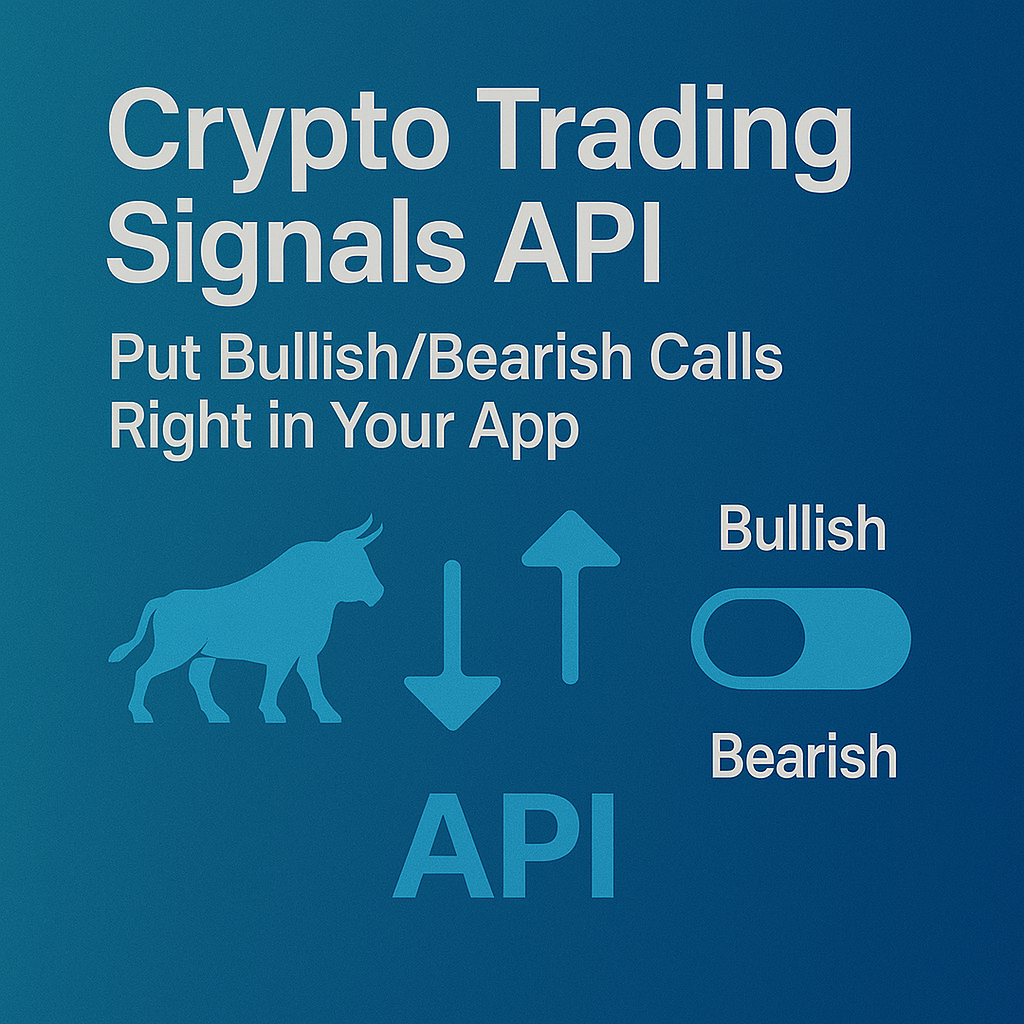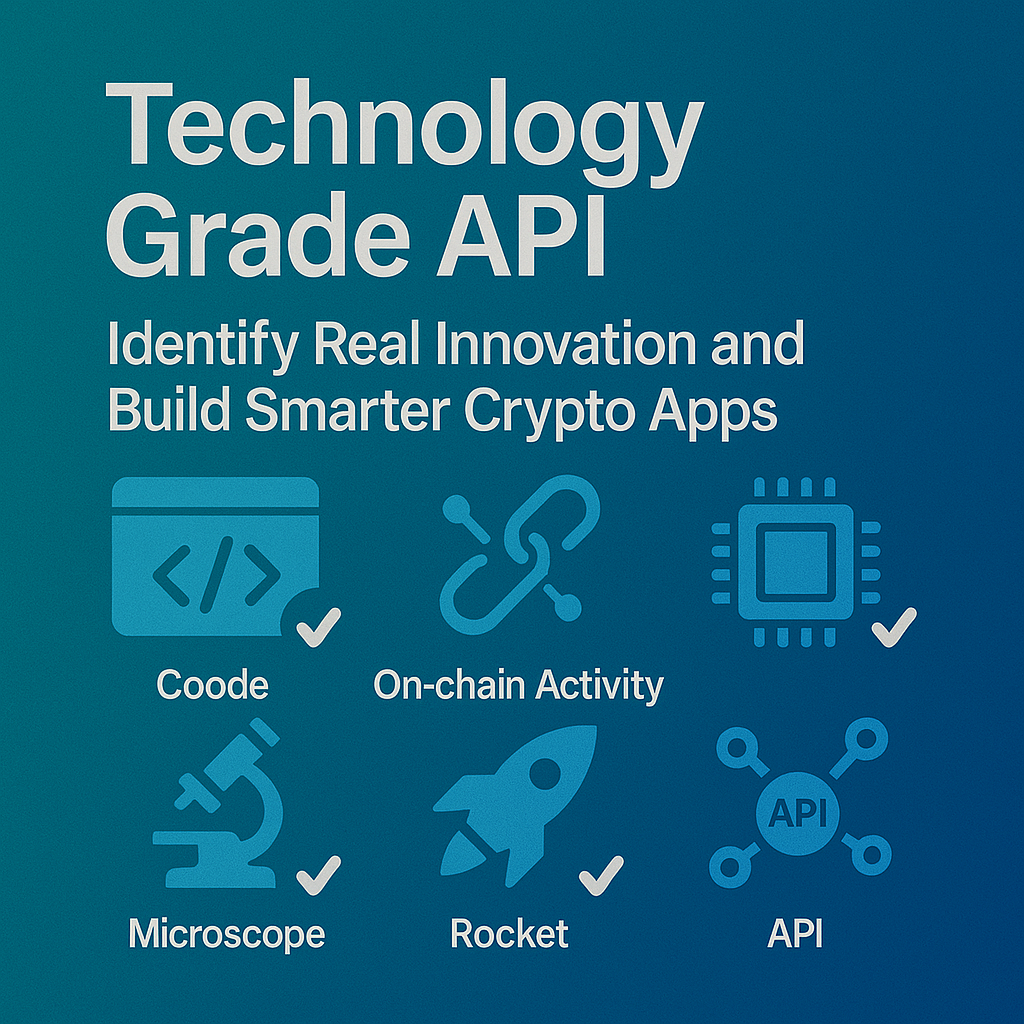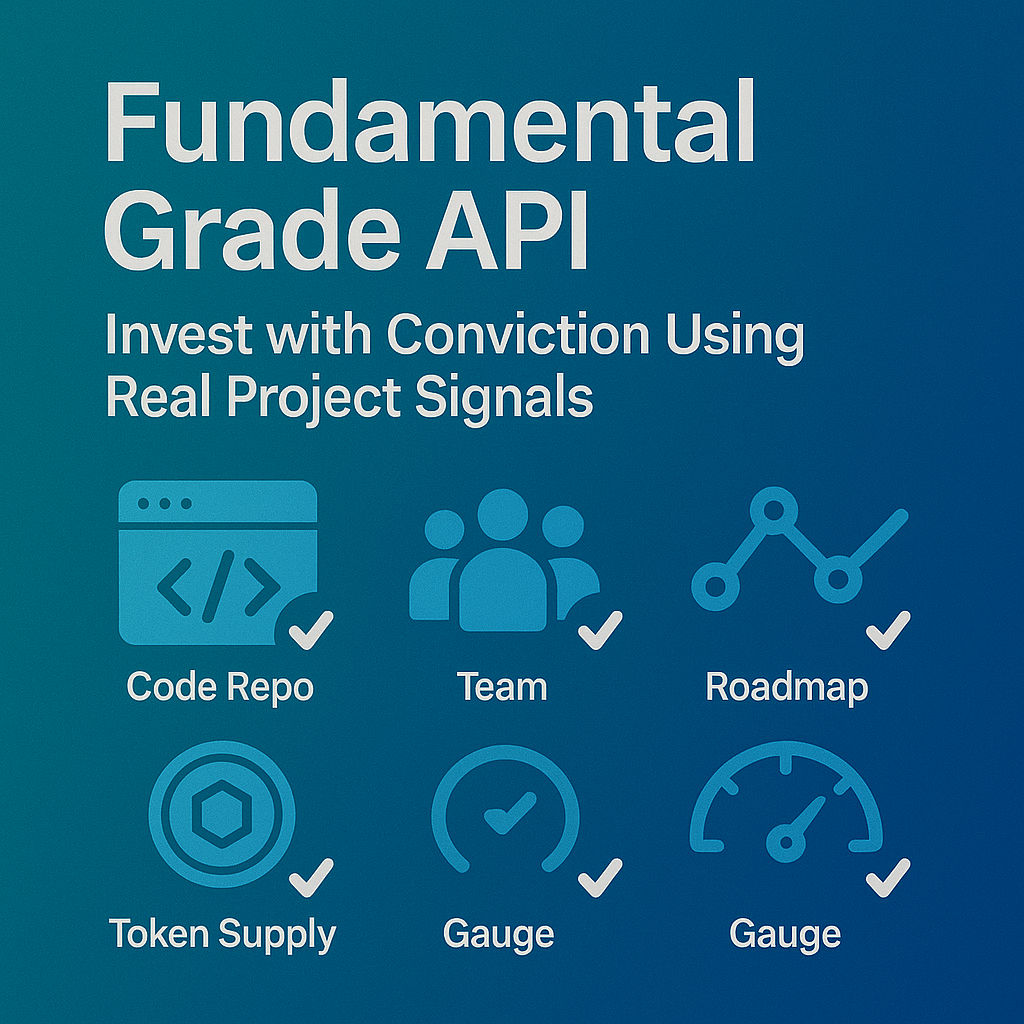Top Crypto Trading Platforms in 2025







%201.svg)
%201.svg)
Big news: We’re cranking up the heat on AI-driven crypto analytics with the launch of the Token Metrics API and our official SDK (Software Development Kit). This isn’t just an upgrade – it's a quantum leap, giving traders, hedge funds, developers, and institutions direct access to cutting-edge market intelligence, trading signals, and predictive analytics.
Crypto markets move fast, and having real-time, AI-powered insights can be the difference between catching the next big trend or getting left behind. Until now, traders and quants have been wrestling with scattered data, delayed reporting, and a lack of truly predictive analytics. Not anymore.
The Token Metrics API delivers 32+ high-performance endpoints packed with powerful AI-driven insights right into your lap, including:
Getting started with the Token Metrics API is simple:
At Token Metrics, we believe data should be decentralized, predictive, and actionable.
The Token Metrics API & SDK bring next-gen AI-powered crypto intelligence to anyone looking to trade smarter, build better, and stay ahead of the curve. With our official SDK, developers can plug these insights into their own trading bots, dashboards, and research tools – no need to reinvent the wheel.
%201.svg)
%201.svg)
Hype is loud, but code is what lasts. The Technology Grade API helps you measure the engineering strength behind a token—scalability, innovation, and real code quality—so you can prioritize serious projects in your bots, dashboards, or research tools. In this guide, you’ll query the /v2/technology-grade endpoint, embed the score in your UI, and ship a feature that turns technical due diligence into a single actionable signal. Start by grabbing your key at Get API Key, Run Hello-TM to validate your first call, then Clone a Template to go live fast.
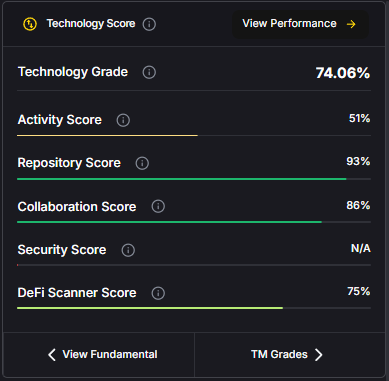
Separate hype from substance. Whitepapers and roadmaps are cheap; shipped code, throughput, and upgrade cadence are not. The Technology Grade API rolls engineering reality into a comparable score so you can rank ecosystems, filter listings, and surface projects with staying power.
Faster diligence, clearer decisions. For bot builders, Technology Grade is an upstream filter that keeps low-quality projects out of your universe. For dashboard builders, it adds credibility—users can see why a project ranks well. And for screeners, it’s a one-score signal that’s easy to sort, badge, and alert on with low latency.
For the Technology Grade information, check the top right of the API Reference. You'll find the cURL request to connect effortlessly.
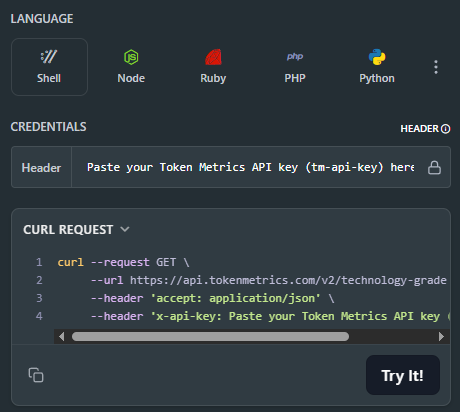
Kick off from quickstarts in the docs—fork a dashboard or screener and deploy. Validate your environment with Run Hello-TM, then scale usage. When you need higher limits and SLAs, compare API plans.
Technology Grade synthesizes engineering-centric evidence—such as throughput/scalability, rate of innovation (feature velocity, upgrade cadence), and code quality (maintainability, robustness cues)—into a normalized score and grade (e.g., Strong / Average / Weak). It’s designed to be comparable across projects and stable enough to inform filters, tiers, and badges.
At query time, you request /v2/technology-grade?symbol=<ASSET>. The response includes the headline score and component scores you can display in bars or a radar chart. For dashboards with many assets, use batched calls and short-TTL caching. If you push upgrade/downgrade alerts, queue notifications or use webhooks to avoid bursty polling.
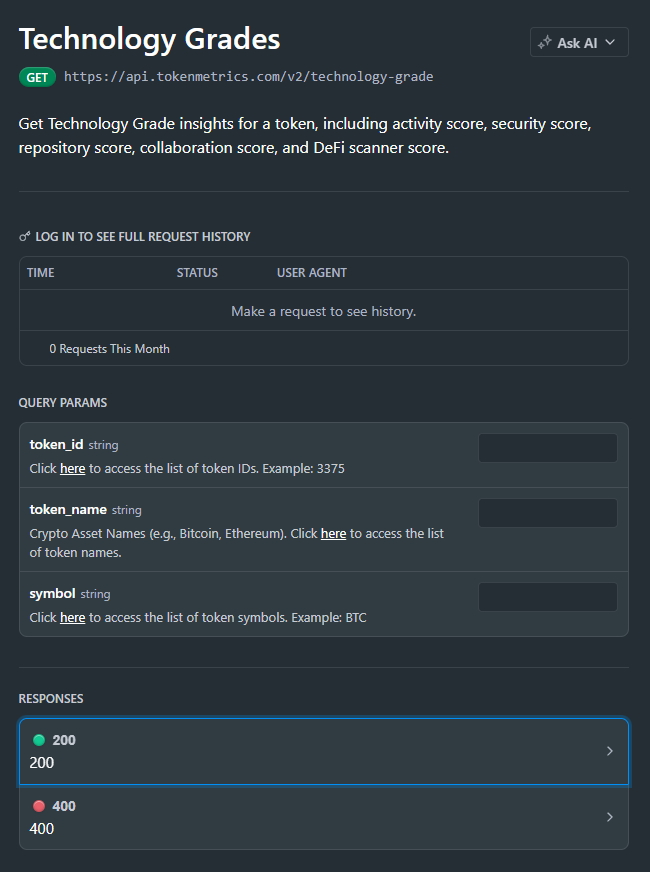
1) What does the Technology Grade API return?
A JSON payload with an overall score/grade plus component scores (e.g., scalability, innovation, code quality) and timestamps. Use the overall score for ranking and components for explanation.
2) Is this real-time, and what about latency/SLOs?
The endpoint is engineered for predictable latency suitable for dashboards and filters. For frequent refresh or alerts, combine short-TTL caching with queued jobs or webhooks to minimize round-trips.
3) How should I combine Technology Grade with other signals?
A common pattern: Technology Grade (engineering quality) + Fundamental Grade (business quality) + TM Grade (technicals/sentiment) + Trading Signals (timing) + Support/Resistance (risk placement).
4) How “accurate” is Technology Grade?
It’s an opinionated synthesis of engineering evidence, not financial advice. Use it as part of a diversified framework; validate with your own backtests and risk controls.
5) Do you provide SDKs or examples?
You can integrate via REST (JS/Python examples above). The docs include quickstarts, Postman collections, and templates—start by Run Hello-TM.
6) Polling vs webhooks for grade changes?
For UI pages, cached polling is fine. For alerts (upgrades/downgrades), prefer webhooks or scheduled jobs to avoid spiky traffic and rate-limit issues.
7) Pricing, limits, and enterprise SLAs?
Begin free and scale up as needed. See API plans for allowances; enterprise SLAs and support are available.
%201.svg)
%201.svg)
Most traders chase price action; Fundamental Grade API helps you see the business behind the token—community traction, tokenomics design, exchange presence, VC signals, and DeFi health—consolidated into one score you can query in code. In a few minutes, you’ll fetch Fundamental Grade, render it in your product, and ship a due-diligence UX that drives trust. Start by grabbing your key at the Get API Key page, Run Hello-TM to verify your first call, then Clone a Template to go live fast.
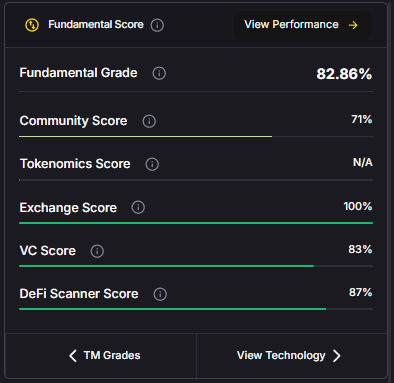
Beyond price, toward quality. Markets are noisy—hype rises and fades. Fundamental Grade consolidates hard-to-track signals (community growth, token distribution, liquidity venues, investor quality, DeFi integrations) into a clear, comparable score. You get a fast “is this worth time and capital?” answer for screening, allocation, and monitoring.
Build trust into your product. Whether you run an investor terminal, exchange research tab, or a portfolio tool, Fundamental Grade lets users justify positions. Pair it with TM Grade or Quantmetrics for a balanced picture: what to buy (fundamentals) and when to act (signals/levels).
The Fundamental Grade is easily accessible in the top right of the API Reference. Grab the cURL request for seamless access!
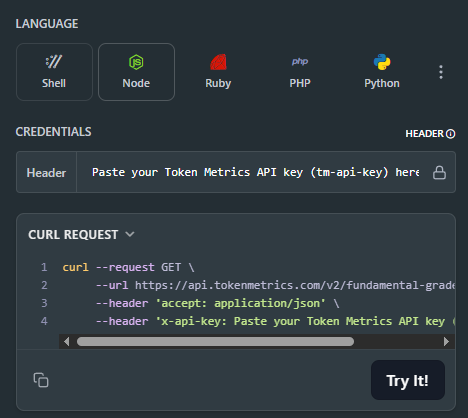
👉 Ready to build? Get API Key • Run Hello-TM • Clone a Template
Kick off from our quickstarts—fork a dashboard or screener template, plug your key, and deploy. If you’re new here, Run Hello-TM first to confirm your environment, then scale into product features. When you outgrow the free tier, compare API plans.
Fundamental Grade aggregates multiple project-quality signals into a normalized score and label (e.g., Strong / Average / Weak). Typical sub-signals include:
At query time, you call /v2/fundamental-grade with a symbol; responses include the overall score plus component scores you can visualize. For dashboards with many assets, batch fetches and short-TTL caching keep pages responsive. If you push alerts (e.g., “Fundamental Grade upgraded”), prefer webhooks or queued jobs to avoid hammering the API.
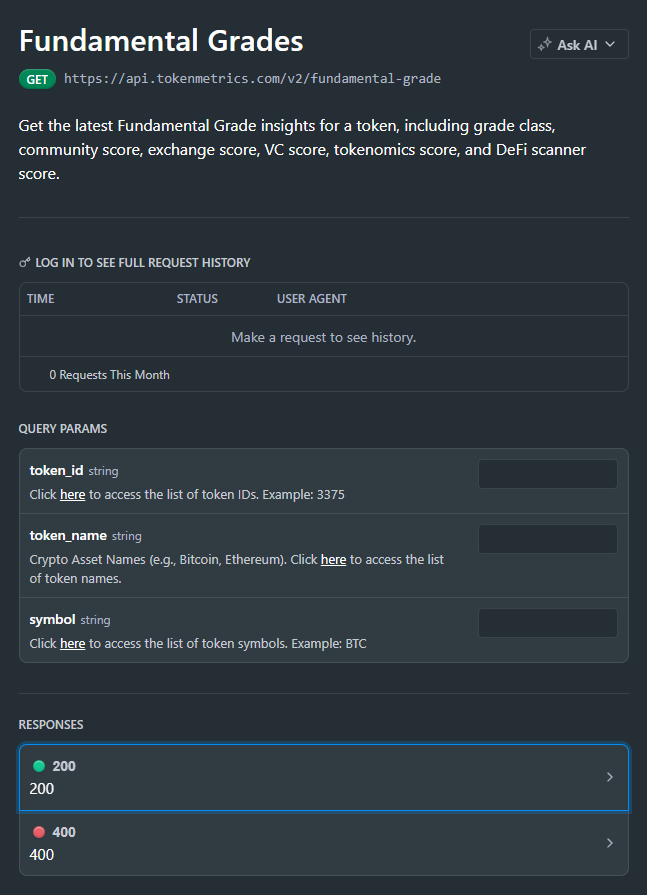
1) What does the Fundamental Grade API return?
A JSON payload with the overall score/grade plus component scores (e.g., community, tokenomics, exchange presence, VC backing, DeFi health) and timestamps. Use the overall grade for ranking and component scores for explanations.
2) How fast is the endpoint? Do you publish SLOs?
The API is engineered for predictable latency. For high-traffic dashboards, add short-TTL caching and batch requests; for alerts, use jobs/webhooks to minimize round-trips.
3) Can I combine Fundamental Grade with TM Grade or signals?
Yes. A common pattern is Fundamental Grade for quality filter + TM Grade for technical/sentiment context + Trading Signals for timing and Support/Resistance for risk placement.
4) How “accurate” is the grade?
It’s an opinionated synthesis of multiple inputs—not financial advice. Historical studies can inform usage, but past performance doesn’t guarantee future results. Always layer risk management and testing.
5) Do you offer SDKs and examples?
You can use REST directly (see JS/Python above). The docs include quickstarts, Postman, and ready-to-clone templates—start with Run Hello-TM.
6) Polling vs webhooks for fundamentals updates?
For UI pages, cached polling works well. For event-style notifications (upgrades/downgrades), prefer webhooks or scheduled jobs to avoid spiky traffic.
7) What about pricing, limits, and enterprise SLAs?
Begin free and scale as you grow. See API plans for allowances; enterprise SLAs and support are available—contact us.
%201.svg)
%201.svg)
Cluttered charts and whipsaw price action make it hard to act with conviction. The TM Grade API turns that noise into a single, opinionated signal you can build on—ideal for trading bots, dashboards, and research tools. In this guide, you’ll pull TM Grade in code, see how it powers products, and ship something useful in minutes. Start with the Get API Key, then Run Hello-TM in the docs and Clone a Template to go live fast.
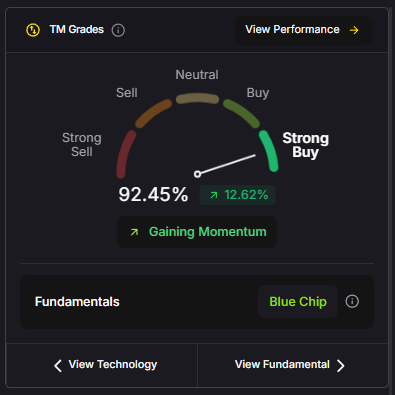
One score, clear decision. TM Grade distills technicals, sentiment, and momentum into a single, interpretable value from Strong Sell → Strong Buy. Instead of juggling indicators, you get an opinionated, trade-ready signal you can rank, alert on, and route into strategies.
Built for builders. Developers integrate TM Grade to filter universes, power dashboards, or trigger bots—with predictable performance and a schema designed for programmatic use. Pair it with webhooks and caching to slash latency and polling costs.
In the top right of the API Reference you can find the curl request for your desired language. This is what you can use to access the TM Grade endpoint.
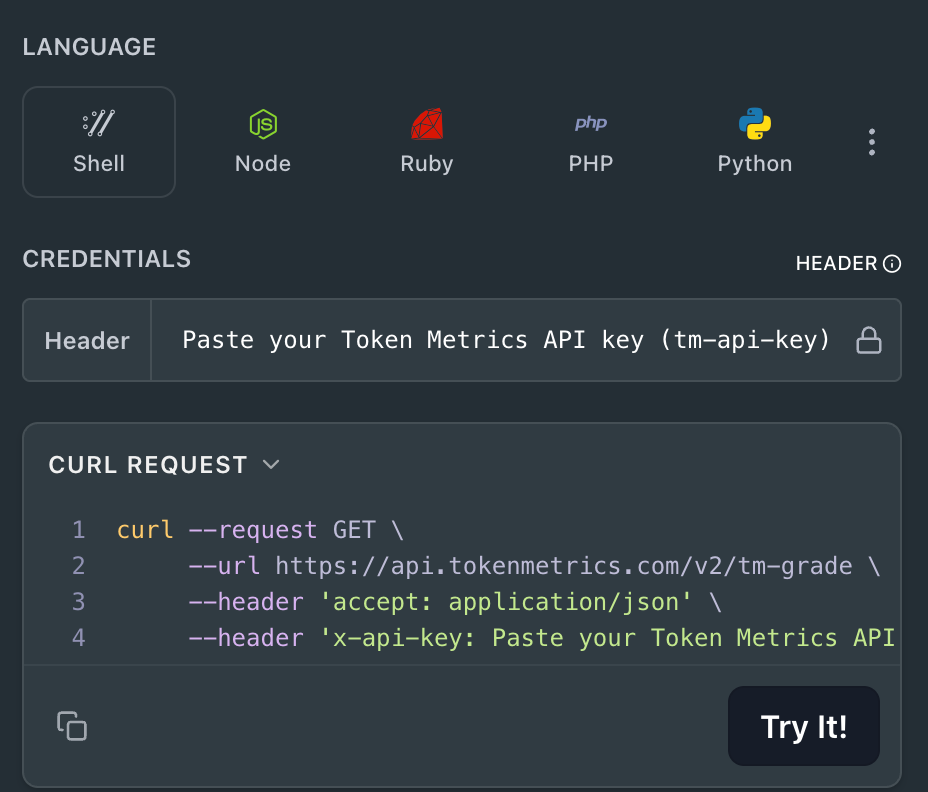
👉 Ready to go further? Get API Key • Run Hello-TM
You can start from our quickstarts in the docs—fork, plug your key, and deploy in minutes. Run Hello-TM to see the first call succeed, then scale into a bot or dashboard. When you’re ready for higher limits, compare API plans.
TM Grade blends multiple evidence streams—technical momentum, market structure, sentiment, and other model inputs—into a single normalized score (e.g., 0–100) and a label (Strong Sell to Strong Buy). This opinionated synthesis is what separates TM Grade from raw market data: it’s designed to be actionable.
Polling vs webhooks. For screens and dashboards, lightweight polling (or cached fetches) is fine. For trading agents and alerting, use webhooks or short polling with backoff and caching to cut latency and call volume. Combine TM Grade with endpoints like /v2/trading-signals for timing or /v2/resistance-support for risk placement.
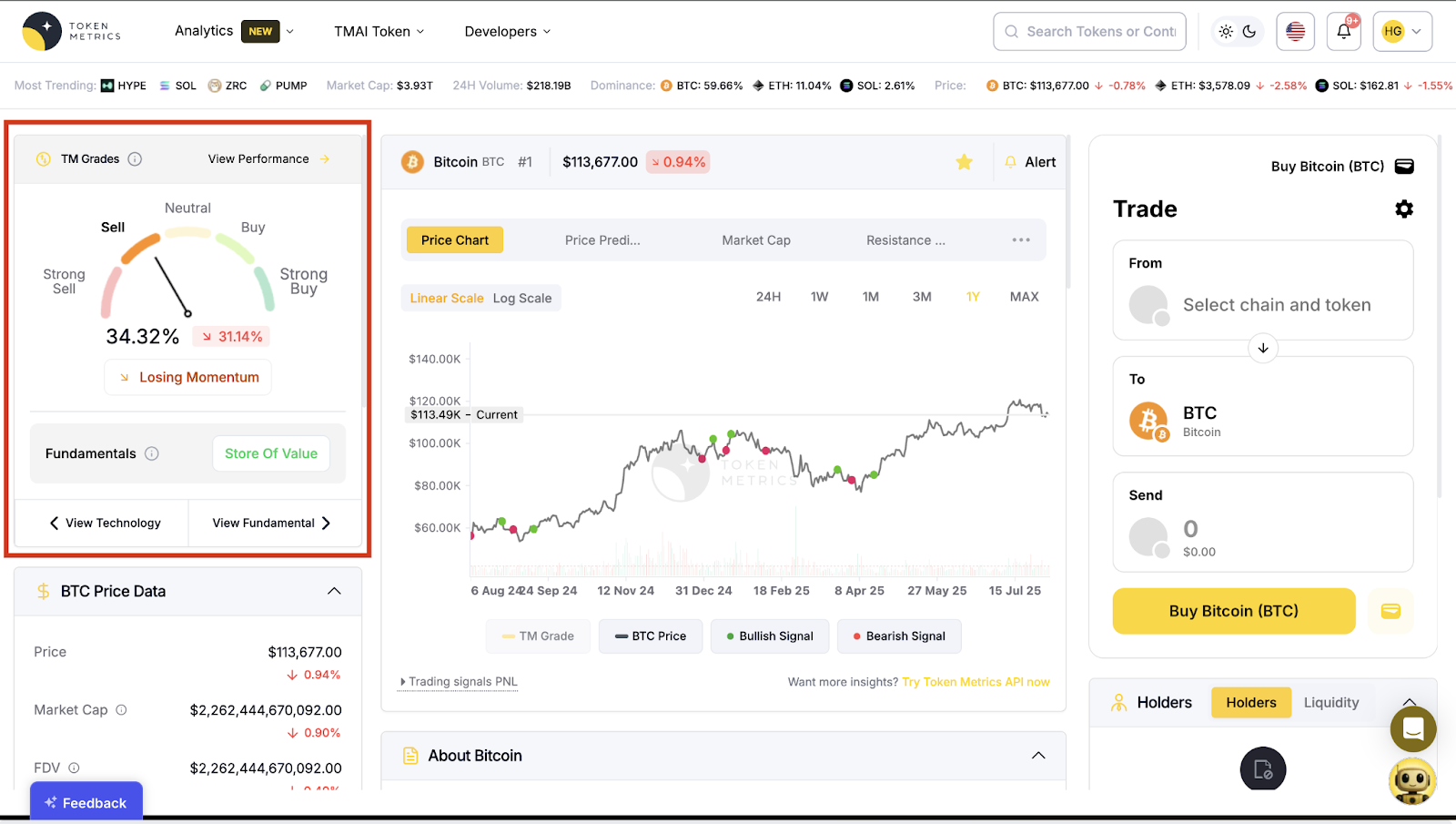
1) What does the TM Grade API return?
A JSON payload with fields like symbol, score (e.g., 0–100), and a categorical grade from Strong Sell to Strong Buy, designed for programmatic ranking, filtering, and display.
2) How fast is it? Do you have latency/SLOs?
TM endpoints are engineered for reliability with predictable latency. For mission-critical bots, add short-TTL caching and webhooks to minimize round-trips and jitter.
3) Can I use TM Grade in trading bots?
Yes. Many developers use TM Grade to pre-filter tokens and pair it with /v2/trading-signals for entries/exits. Always backtest and paper-trade before going live.
4) How accurate is TM Grade?
TM Grade is an opinionated model synthesizing multiple inputs. Backtests are illustrative—not guarantees. Use it as one component in a diversified strategy with risk controls.
5) Do you have SDKs and examples?
Yes—JavaScript and Python examples above, plus quickstarts and templates in the docs: Run Hello-TM.
6) Polling vs webhooks—what should I pick?
Dashboards: cache + light polling. Bots/alerts: prefer webhooks (or event-driven flows) to reduce latency and API usage.
7) Pricing, limits, and enterprise SLAs?
You can start free and scale up as you grow. See API plans for rate limits and tiers. Enterprise options and SLAs are available—contact us.

%201.svg)
%201.svg)
As we move further into 2025, the best crypto altcoins are capturing the attention of both retail investors and professional traders worldwide. While Bitcoin and Ethereum remain dominant assets anchoring the cryptocurrency market, the altcoin market is witnessing a surge of innovation fueled by advancements in AI, decentralized finance (DeFi), and smart contracts. Crypto coins are a fundamental category of digital assets, serving as native currencies on their respective blockchains and playing a crucial role in transactions and ecosystem functions. Altcoins can apply different consensus protocols for transaction verification and may offer unique or better features and functions compared to Bitcoin. This dynamic environment presents unparalleled opportunities for investors seeking to diversify their portfolios beyond the most cryptocurrencies and explore promising altcoin investments with high growth potential.
In this article, we will explore the top 15 best crypto altcoins to watch in 2025. These projects span various sectors such as AI integration, Web3, decentralized compute, and the creator economy. Each altcoin offers unique utilities, competitive advantages, and strong communities, making them attractive options for those interested in long-term investments or active trading. A skilled and capable project team behind an altcoin can indicate its long-term success potential. Understanding these altcoins’ value propositions and market dynamics is essential. It’s important to note the distinction between coins (or crypto coins) and tokens: coins, also referred to as crypto coins, function as the primary currency or utility within their blockchain ecosystems, while tokens often serve specific purposes on top of existing blockchains. This clarification will help investors navigate the crypto ecosystem more effectively while managing risk tolerance in a space known for price fluctuations.
The cryptocurrency market has rapidly evolved into a global financial ecosystem, with its total market capitalization now exceeding $2 trillion. This vibrant crypto space is home to a wide array of digital currencies, including Bitcoin, altcoins, and various tokens, each offering unique features and use cases. Unlike traditional financial institutions, the crypto market operates on a decentralized platform, enabling peer-to-peer transactions and the execution of smart contracts without intermediaries. While this independence fosters innovation and accessibility, it also introduces significant price fluctuations and volatility. Altcoins carry more risk than Bitcoin and many of the smaller ones may not be trustworthy investments. As a result, investors must conduct thorough research and understand the inherent risks before participating in the cryptocurrency market. Whether you’re exploring Bitcoin or the latest altcoins, staying informed and cautious is essential for navigating this dynamic and often unpredictable market.
The cryptocurrency market landscape is incredibly diverse, boasting over 10,000 different cryptocurrencies. While Bitcoin remains the most recognized and widely held asset, altcoins such as Ethereum, Binance Coin, and Ripple have carved out substantial market shares and are favored by many investors. Cardano (ADA) is an advocate for proof-of-stake consensus and offers a blockchain solution with low fees and high security. The market capitalization of these altcoins can shift dramatically, often influenced by market sentiment, technological advancements, and broader economic trends. Financial institutions and regulatory bodies like the Securities and Exchange Commission are increasingly engaging with the crypto market—some by investing directly, others by establishing guidelines to ensure investor protection and market integrity. Decentralized finance (DeFi) has emerged as a transformative force within the crypto market, offering innovative platforms for lending, borrowing, and trading that operate independently of traditional banks. As the market continues to mature, understanding the interplay between these elements is crucial for anyone looking to invest or trade in cryptocurrencies.
Altcoin season is a phenomenon in the crypto market where altcoins outperform Bitcoin, often resulting in rapid increases in altcoin prices. These periods are typically driven by shifts in market sentiment and emerging trends, making them highly attractive to investors seeking significant returns. However, the crypto market is known for its volatility, and price fluctuations can be swift and unpredictable. Seasoned crypto investors often employ strategies such as diversification and risk management to navigate these turbulent times. For example, Bitcoin Cash has experienced notable price swings during past altcoin seasons, attracting traders looking to capitalize on these movements. Bitcoin Cash (BCH) offers fast transaction times and lower fees compared to Bitcoin, making it a popular choice during these periods. Staying attuned to market trends and sentiment is essential for making informed decisions and maximizing opportunities during altcoin season, while also managing the inherent risks of trading in such a dynamic environment.
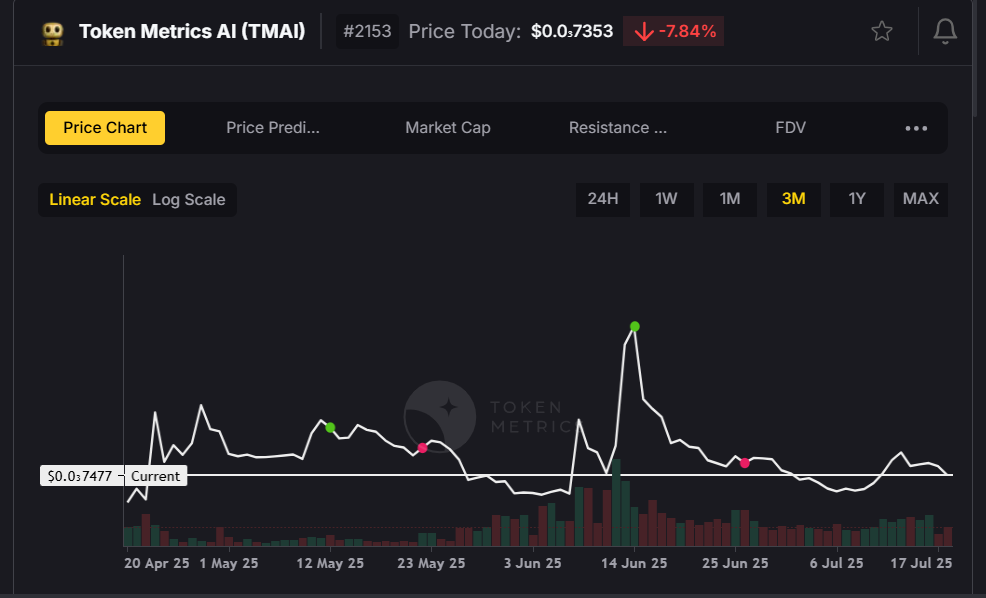
Token Metrics AI ($TMAI) stands out as a groundbreaking project that merges AI with crypto analytics to empower smarter investing decisions. This platform offers an all-in-one AI trading assistant that combines autonomous agent tooling, on-chain infrastructure, and predictive analytics. Users can stake $TMAI tokens to access features like crypto indices, research automation, and trader/investor grading systems.
The Token Metrics AI platform is particularly valuable for seasoned crypto investors and traders who rely on data-driven insights to navigate the volatile crypto market. Its integration with various tools, including Signals and Smart Agents, facilitates seamless trading and investing processes by streamlining the process of executing trades, analyzing data, and managing assets through a clear workflow. With $TMAI, users benefit from a sophisticated ecosystem designed to optimize returns and reduce the guesswork commonly associated with altcoin trading.
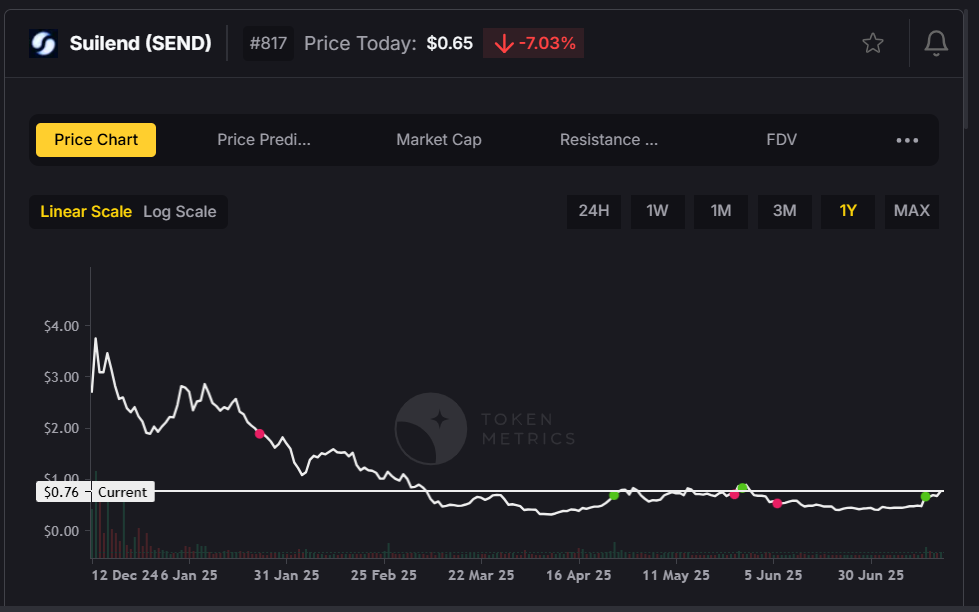
Suilend ($SEND) is a native DeFi lending protocol built on the Sui blockchain, which is gaining traction due to its low transaction fees and innovative parallel transaction processing. The platform's low fees provide a competitive advantage for users, making it especially appealing to cost-conscious traders and investors. As the Sui network expands, Suilend is positioned to capitalize on the growing demand for capital-efficient lending and borrowing services.
The platform supports Sui-native tokens, enabling users to leverage their crypto assets efficiently within a low-competition DeFi environment. This makes $SEND an attractive option for investors seeking exposure to decentralized finance with minimized transaction fees and a scalable infrastructure. Its rapid total value locked (TVL) growth underscores its rising market value and adoption.
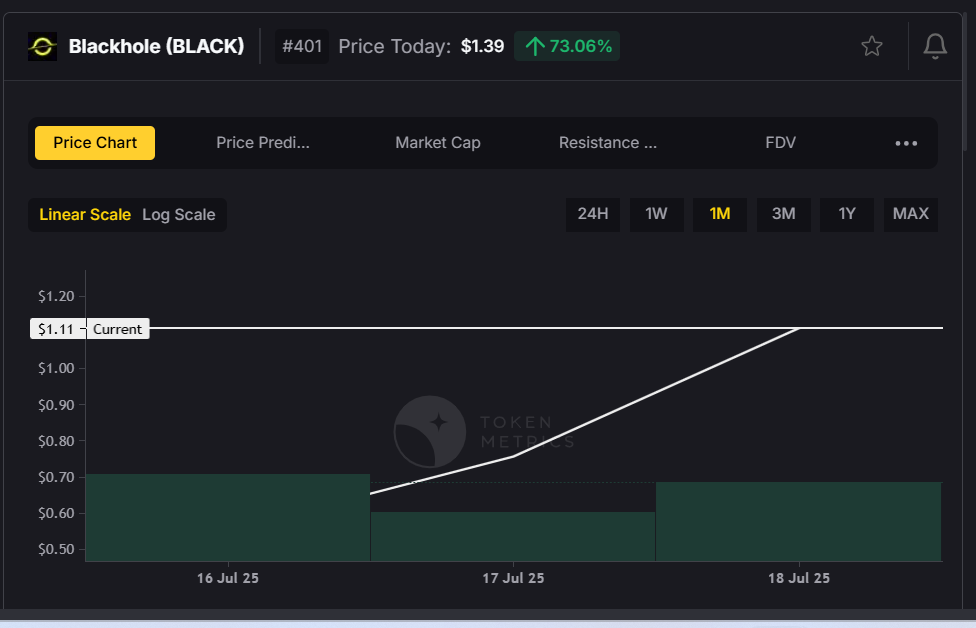
Blackhole ($BLACK) is carving a niche as a decentralized compute platform that provides GPU resources for AI, machine learning, and crypto infrastructure projects. By incentivizing GPU providers and AI developers through its native $BLACK token—the native coin of the Blackhole platform, essential for transaction fees and overall platform operations—the platform fosters a collaborative environment for decentralized AI compute sharing.
This project is pivotal for the evolving decentralized finance and AI sectors, offering a decentralized platform where compute power can be rented and shared securely. For investors interested in the intersection of AI and blockchain technology, Blackhole represents a unique asset with the potential to disrupt traditional centralized compute services.
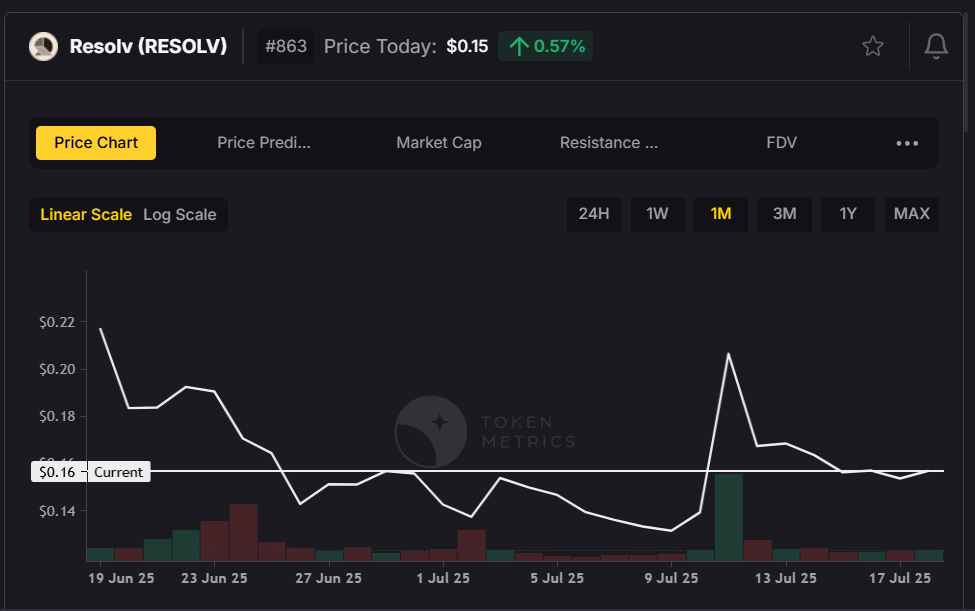
Resolv ($RESOLV) innovates at the crossroads of AI and smart legal contracts by developing AI agents that automate compliance, arbitration, and dispute resolution. This platform empowers decentralized autonomous organizations (DAOs) and dApps with tools for on-chain contract enforcement and legal agreement automation.
As regulatory scrutiny from bodies like the Securities and Exchange Commission increases, projects like Resolv that enhance legal transparency and automation are becoming essential. By integrating large language models (LLMs) into smart contracts, Resolv offers a competitive edge in the crypto space, appealing to users and investors focused on compliance and decentralized finance.
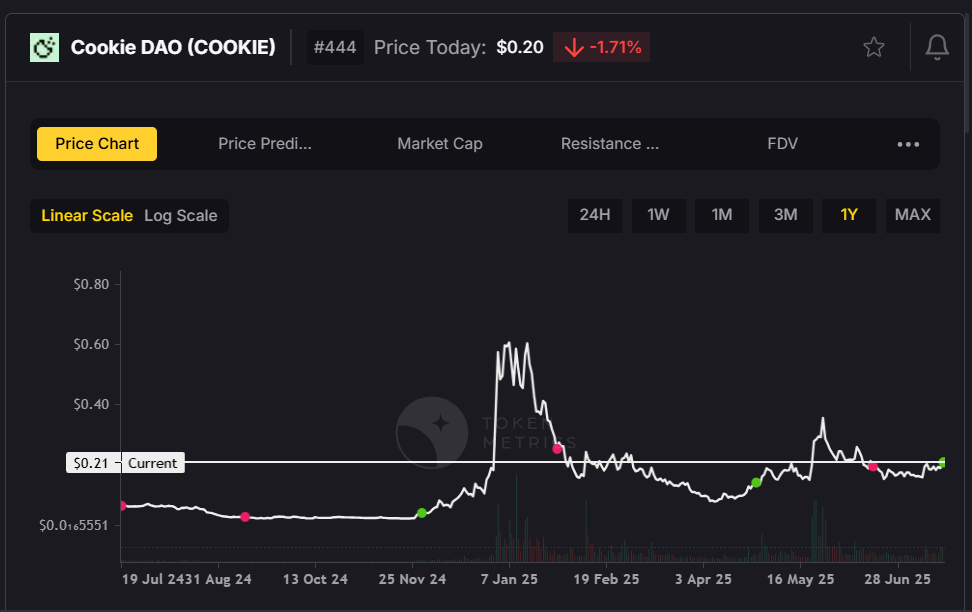
Cookie.fun ($COOKIE) blends social engagement, AI creativity, and entertainment by offering AI-generated animated content and meme NFTs. This platform leverages the virality of meme culture to create a decentralized social environment where creators and fans can monetize digital content.
The unique combination of meme NFTs and community rewards makes Cookie.fun a standout in the creator economy. For crypto enthusiasts looking to participate in the cultural side of the crypto market, $COOKIE offers a novel way to engage with digital assets while benefiting from the rise of AI-generated entertainment.
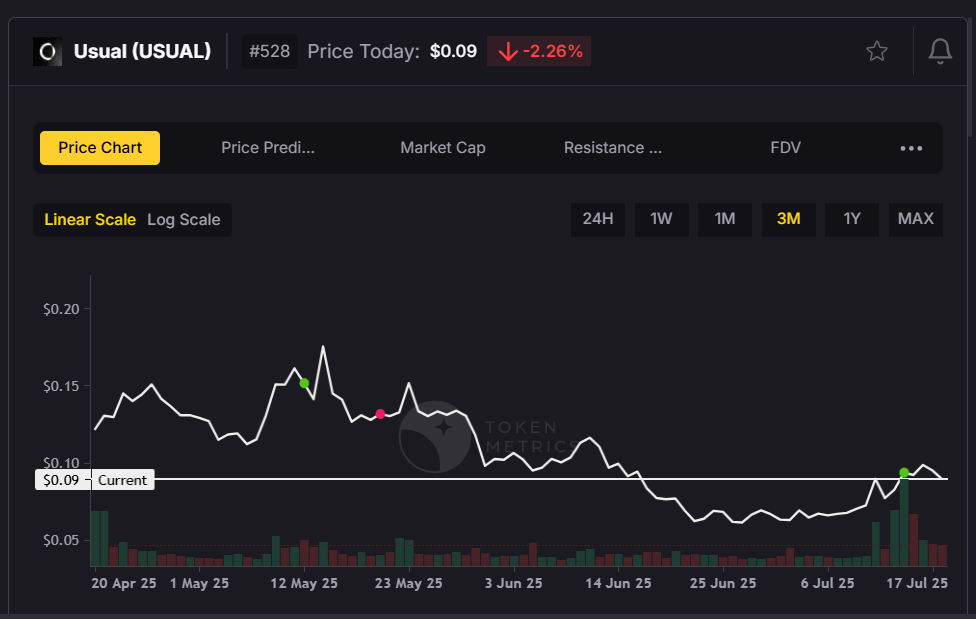
Usual Money ($USUAL) addresses the need for a user-friendly, decentralized stablecoin platform optimized for DeFi payments and yield generation. By combining a seamless user experience with smart routing for capital efficiency, Usual Money enhances the dollar experience for crypto-native users.
This platform’s focus on yield-bearing stablecoins and low transaction fees positions it well within the growing decentralized finance sector. Investors seeking stable, utility-driven tokens with real-world applications in payments and DeFi will find $USUAL an appealing asset.
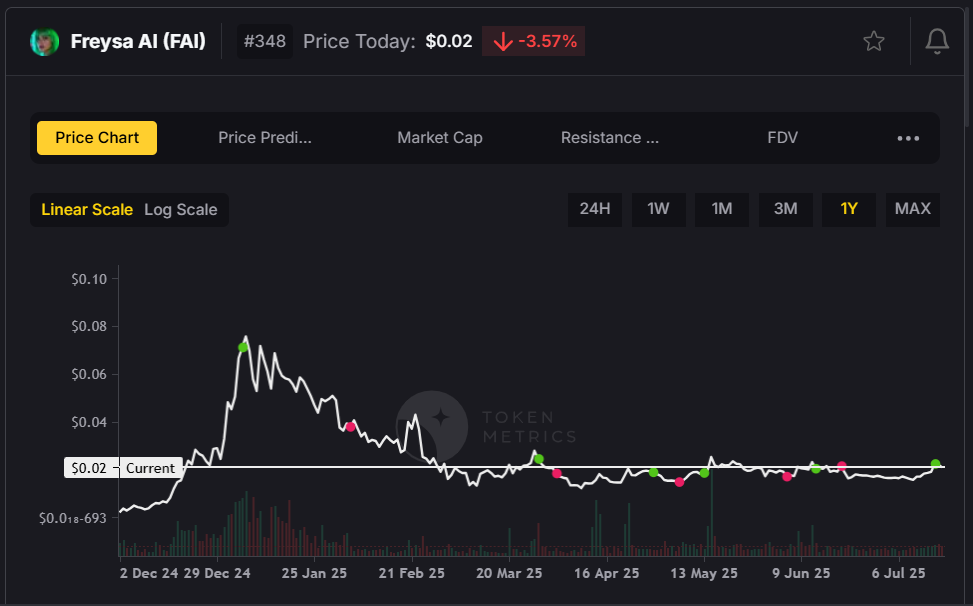
Freysa AI ($FAI) is building a decentralized framework for AI agents capable of interacting with blockchains, decentralized exchanges (DEXes), and dApps. This infrastructure supports on-chain automation and facilitates the development of crypto copilots that enhance user interaction within the crypto ecosystem.
By integrating leading AI models with on-chain APIs, Freysa AI offers a powerful toolset for developers and users aiming to streamline complex processes. Its role in decentralized AI infrastructure makes $FAI a promising token for investors focused on the future of AI-driven blockchain applications.
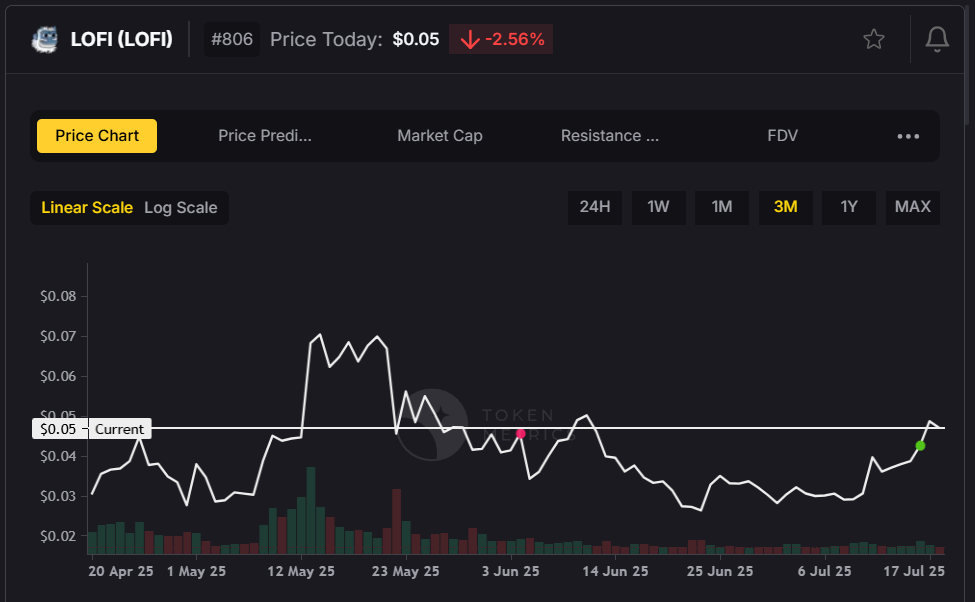
LOFI is an innovative project at the intersection of AI, music, and culture. It enables artists and fans to co-create and monetize AI-generated generative music NFTs, focusing on ambient soundscapes and fan engagement.
This platform taps into the creator economy by facilitating music royalties and fostering fan economies through blockchain technology. LOFI’s unique approach to combining generative music with NFTs offers a fresh avenue for investors interested in cultural and entertainment-related crypto assets.
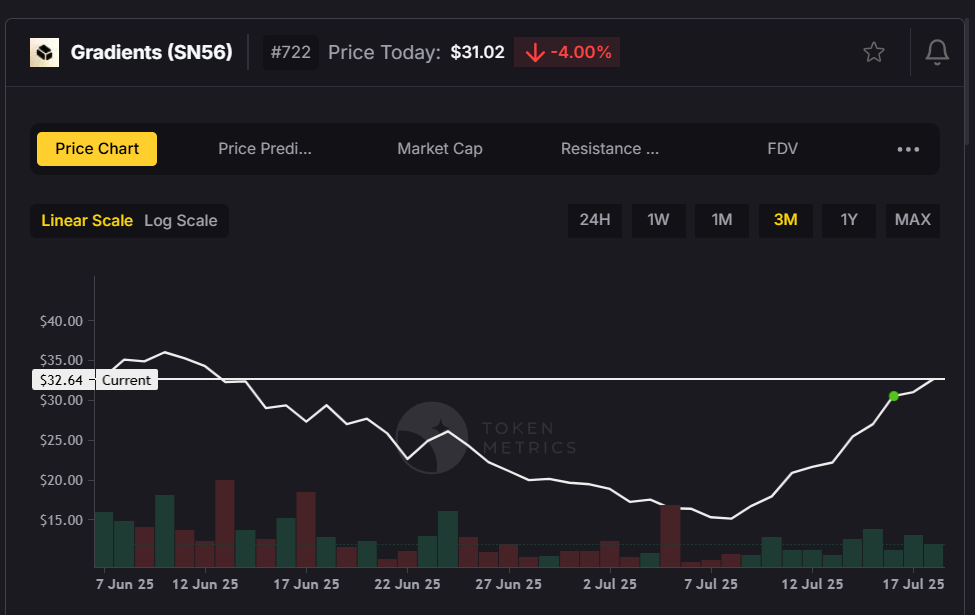
Gradients ($SN56) operates a token-incentivized data marketplace that crowdsources datasets for AI training and machine learning model development. This decentralized approach to data collection and sharing enhances the quality and accessibility of training data for AI developers.
With token-gated access to proprietary datasets, Gradients empowers users and developers to contribute to and benefit from the growth of AI capabilities. Investors focused on AI and data-driven crypto projects will find $SN56 an intriguing addition to their portfolios.
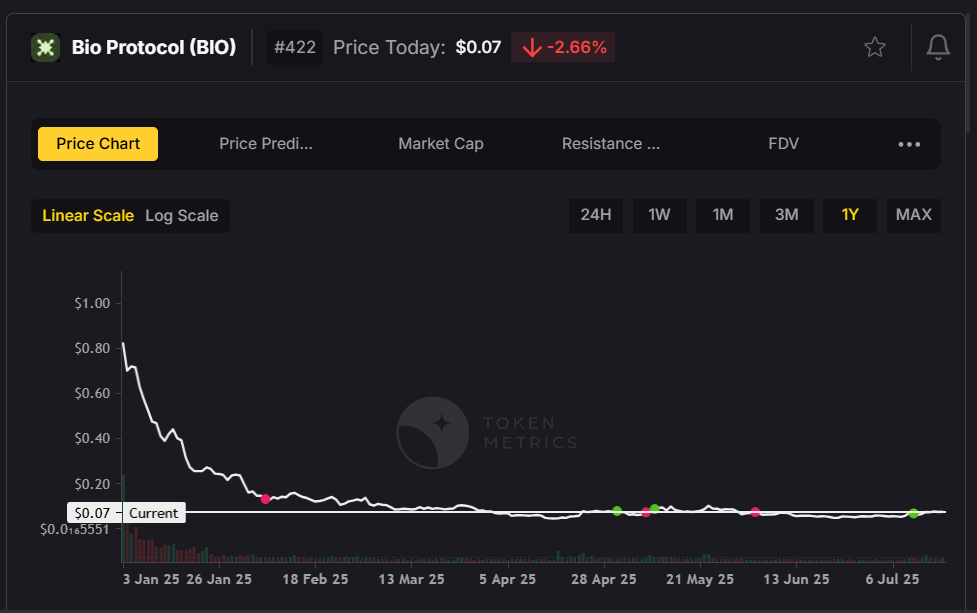
BIO Protocol ($BIO) merges biotechnology with decentralized science (DeSci) by enabling researchers and biotech firms to tokenize experiments and scientific contributions. This platform fosters on-chain reputation systems and data royalties, incentivizing scientific innovation and collaboration.
By facilitating AI-driven drug discovery and scientific data sharing, BIO Protocol addresses real-world challenges through blockchain technology. This project appeals to investors interested in the convergence of biotech, AI, and decentralized finance.
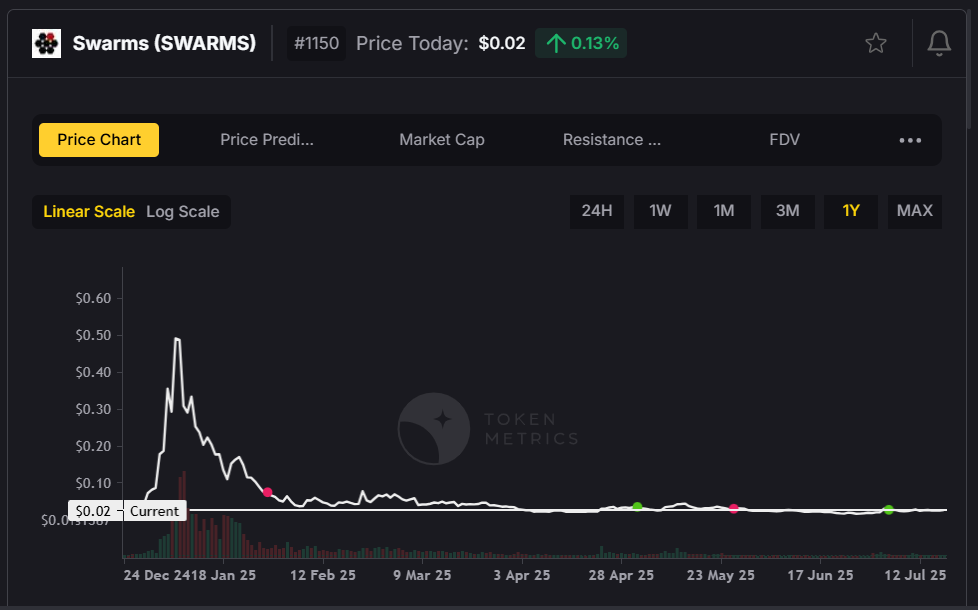
Swarms ($SWARMS) is developing an open-source protocol for multi-agent coordination across decentralized applications. This technology enables smart agents to execute complex tasks such as DAO governance, DeFi arbitrage, and airdrop farming efficiently.
The platform’s swarm AI logic supports parallelized on-chain execution, enhancing scalability and automation. For traders and investors looking at the next wave of decentralized automation, $SWARMS offers compelling utility and growth potential.
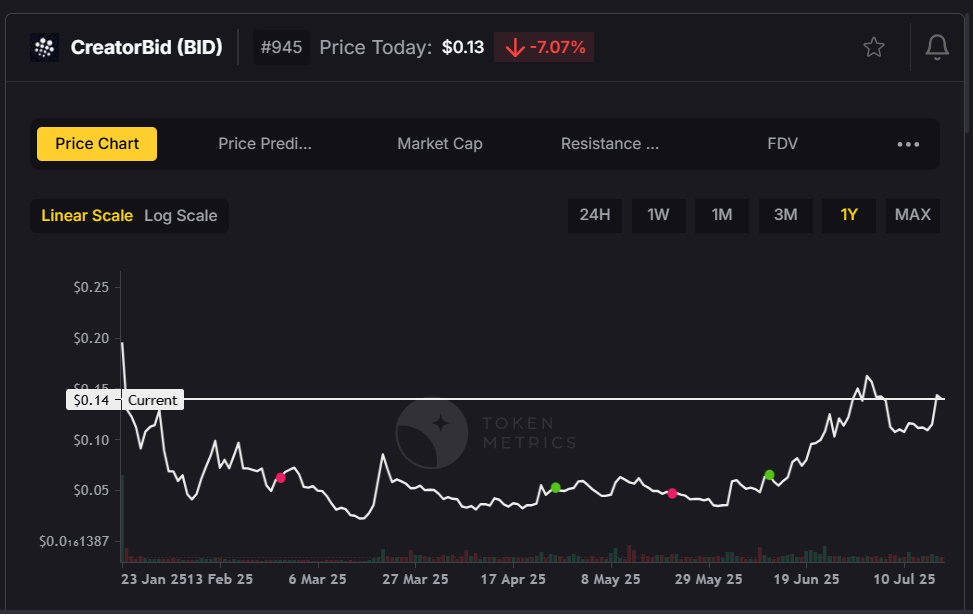
Creator.bid ($BID) is an auction platform where fans can bid on personalized content created by AI-powered influencers and creators. This project combines AI celebrity clones with fan tokens to revolutionize creator monetization.
Its auction dynamics and custom content-generation models provide a unique marketplace within the creator economy. Investors interested in AI-driven social platforms and fan engagement will find $BID an exciting asset.
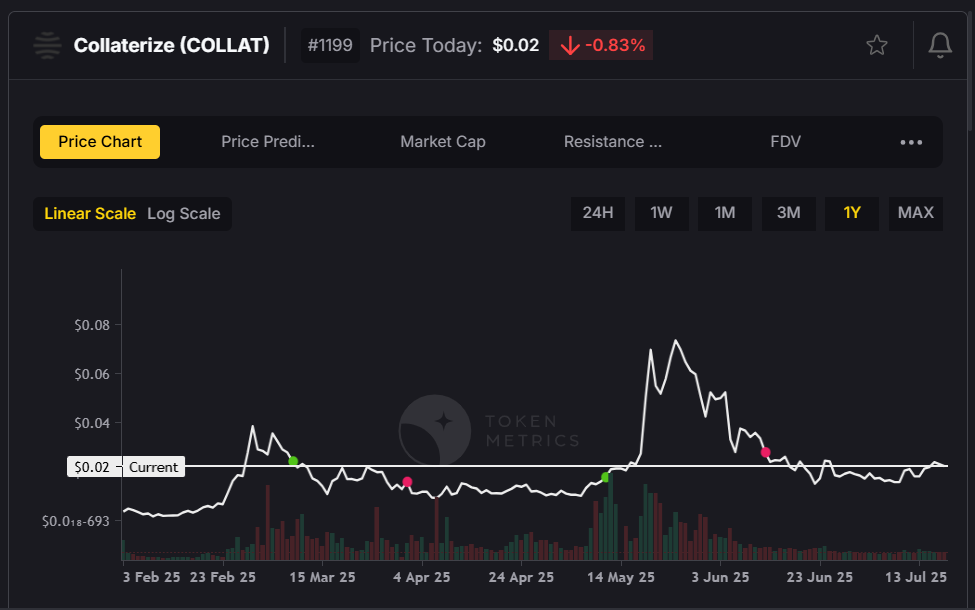
Collaterize ($COLLAT) bridges the gap between real-world assets and decentralized finance by allowing users to tokenize and collateralize assets such as invoices and real estate. This integration facilitates asset-backed lending and yield generation within DeFi.
With transparent smart contracts and real-world audits, Collaterize enhances trust and security for investors. This project is particularly appealing to those seeking exposure to real-world asset (RWA) collateralization in the crypto market.
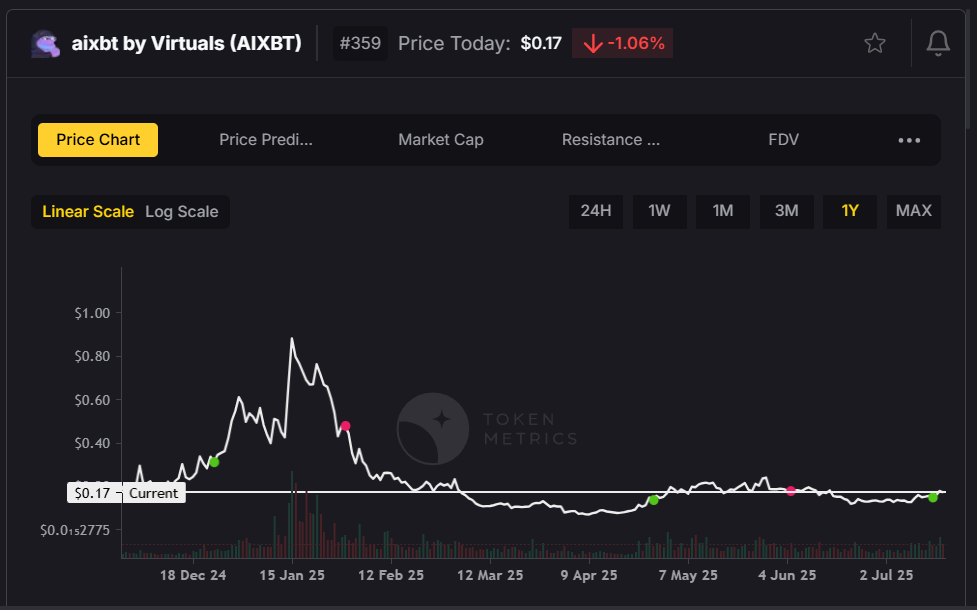
aixbt ($AIXBT) is an AI-powered trading bot platform that leverages both on-chain and off-chain data to execute autonomous crypto trading strategies. The platform enables users to trade altcoins using advanced AI-driven tools, providing flexibility and efficiency in managing a diverse portfolio. It offers real-time trade simulations and leaderboard-based strategy competitions.
This platform caters to traders looking for sophisticated, data-driven tools to navigate price fluctuations and market sentiment. $AIXBT’s innovative approach to AI trading bots makes it a valuable asset in the competitive crypto trading landscape.
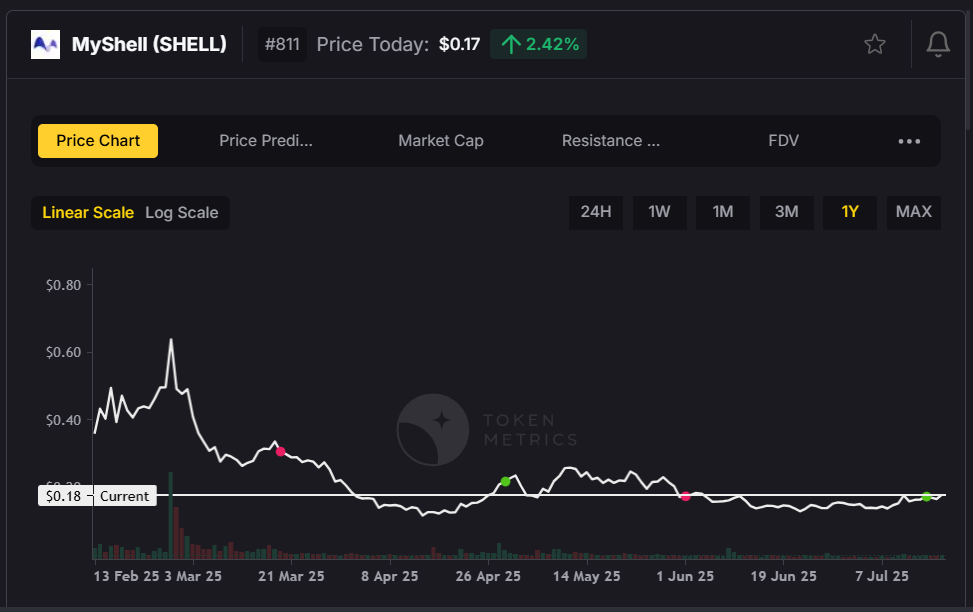
MyShell AI ($SHELL) enables users to create voice-based AI characters that operate across multiple platforms like Discord and Telegram. This project supports voice-to-earn economies and multi-platform bot deployment, enhancing user interaction and customer support.
By combining AI agents with creator studios, MyShell AI taps into the growing demand for personalized, voice-enabled digital experiences. Investors interested in AI-driven user engagement and decentralized platforms will find $SHELL noteworthy.
Trading altcoins successfully requires a solid grasp of the crypto market and its ever-changing trends. Professional traders often rely on technical analysis, chart patterns, and market indicators to anticipate price movements and make strategic trades. When trading altcoins, it’s important to consider factors such as trading fees, transaction fees, and the overall volatility of digital currencies. Understanding the underlying technology, use cases, and competitive landscape of each altcoin can provide a significant edge. Many exchanges, including industry leaders like Binance and Kraken, offer robust platforms for trading a wide variety of altcoins, making it easier for investors to access and trade these digital assets. By staying informed and leveraging the right tools, traders can navigate the complexities of the crypto market and optimize their trading strategies for better results.
Investing in altcoins presents unique challenges, including high price volatility, potential market manipulation, and evolving regulatory landscapes. Retail investors must be proactive in managing these risks by diversifying their portfolios and conducting thorough research before making any altcoin investments. Long term investments in altcoins can yield substantial rewards, but they require a deep understanding of the crypto market and its shifting dynamics. The Securities and Exchange Commission has provided guidelines to help investors navigate the regulatory aspects of cryptocurrency investing, and it’s crucial to ensure compliance with these rules. Platforms like Tron Network and Ripple Labs have introduced low-fee structures and stablecoin solutions to help mitigate some of the risks associated with trading and investing in altcoins. By understanding both the risks and potential rewards, investors can make informed decisions and confidently participate in the ever-evolving world of altcoins and digital assets.
Selecting the best crypto altcoins for 2025 requires thorough research and a strategic approach. Investors should prioritize projects with strong narratives aligned to AI, DeFi, real-world assets, and autonomous agents. Active development and vibrant communities are essential indicators of a project’s sustainability and growth potential. Monitoring new coins entering the market is important, as their supply and circulating supply can impact scarcity and value.
Real token utility and demand mechanisms, such as staking, transaction fee savings, or governance rights, add tangible value to crypto tokens. Interoperability with expanding ecosystems like Sui, Base, and Solana further enhances an altcoin’s market capitalization and market cap stability.
For many investors and traders, platforms like Token Metrics AI ($TMAI) serve as critical tools to analyze market data, track performance, and gauge market sentiment. Crypto prices are influenced by supply, demand, and trading activity, so understanding these factors is crucial for evaluating altcoins. Utilizing such resources can help navigate the complexities of the cryptocurrency market, balancing risk tolerance with the pursuit of high-reward altcoin investments.
In summary, the best crypto altcoins in 2025 are those that combine innovative technology, competitive advantages, and real-world applications within a rapidly evolving crypto ecosystem. When comparing altcoins to other cryptocurrencies, it is important to consider their performance, trading volume, and the platforms they utilize—such as the XRP ledger, which supports fast transactions and differs from traditional blockchains. How actively an altcoin is traded can also indicate its liquidity and investor interest. By staying informed and leveraging cutting-edge platforms, investors can position themselves to capitalize on the rise of new crypto assets and the next altcoin season.

%201.svg)
%201.svg)
Cryptocurrency enthusiasts constantly search for fresh and inventive approaches to maximize their digital assets and earnings. Over the past few years, staking Cardano has emerged as a popular method in this endeavor.
Staking Cardano presents an excellent opportunity for individuals interested in passive income generation. Staking involves actively contributing to a blockchain network and receiving additional cryptocurrency as a reward.
With its reputation as the "Ethereum killer," Cardano provides a dependable and secure platform for staking its native cryptocurrency, ADA.
This comprehensive guide will explore everything you need to know about Cardano staking, including what it is, how to stake it, the pros and cons, and where to do so. Let's dive in!
Cardano is a proof-of-stake (PoS) blockchain founded by Ethereum co-founder Charles Hoskinson. PoS blockchains, unlike proof-of-work (PoW) blockchains like Bitcoin, validate transactions and produce blocks through staking rather than mining.
Staking involves locking away coins in a node to validate transactions and contribute to the network's security and stability. By staking ADA, you can earn staking rewards without moving or losing your coins.
In Cardano's PoS blockchain, nodes play a crucial role in the validation process. Nodes are groups of people who have pooled their staked ADA tokens together.
The more ADA coins locked away in a node, the higher the chances of producing blocks and earning rewards. Staking pools, often operated by those with technical expertise, allow users to pool their tokens with others or run their own staking pool.
Staking Cardano is a straightforward process that can be done through reputable crypto exchanges or by staking directly with staking pool operators. Let's explore both methods.
If you prefer a user-friendly and convenient option, staking Cardano via a crypto exchange might be the right choice. Here's a step-by-step guide on how to stake Cardano via an exchange:
Staking directly with staking pool operators offers more independence and control over your assets. Here's how to stake Cardano with staking pool operators:
It's important to note that staking with staking pool operators allows you to retain full control of your funds and withdraw them at any time.
Before diving into Cardano staking, it's essential to consider the pros and cons. Let's explore the advantages and disadvantages of staking Cardano.
Pros of Cardano Staking
Cons of Cardano Staking
Despite these potential drawbacks, Cardano staking remains an attractive option for those earning passive income from their ADA holdings.
You can stake your Cardano (ADA) tokens, including popular exchanges and dedicated wallets. Let's explore some of the platforms where you can stake Cardano.
Staking on Coinbase
Coinbase, a leading cryptocurrency exchange, offers Cardano staking with an annual percentage yield (APY) of 3.75%. Here's how to stake Cardano on Coinbase:
Staking on Binance
Binance, one of the largest cryptocurrency exchanges, offers Cardano staking with an APY of up to 6.1%. Here's how to stake Cardano on Binance:
Staking on eToro
eToro, a popular social trading platform, offers automatic staking of supported cryptocurrencies, including Cardano. Here's how to stake Cardano on eToro:
While Cardano staking offers numerous benefits, knowing the associated risks is important. Here are some risks to consider before staking Cardano:
It's vital to conduct thorough research and carefully consider these risks before engaging in Cardano staking.
Q1. Is Cardano staking safe?
Yes, Cardano staking is generally considered safe. The ADA tokens used for staking never leave your wallet, and staking rewards are earned similarly to interest in a savings account. However, practicing proper wallet security measures to protect your funds is important.
Q2. Can I unstake my ADA at any time?
Yes, you can unstake your ADA anytime, but it's essential to consider the lock-up period associated with your chosen staking duration. Withdrawing your ADA before the end of the staking duration may result in losing staking rewards.
Q3. Can I stake Cardano if I don't have technical expertise?
Yes, even if you don't have technical expertise, you can stake Cardano by using reputable crypto exchanges that offer staking services. These platforms provide user-friendly interfaces that simplify the staking process.
Q4. How often are staking rewards distributed?
Staking rewards are typically distributed at the end of each epoch, which lasts approximately five days. The distribution of rewards is based on the snapshot taken at the end of each epoch, reflecting the distribution of staked ADA tokens.
Cardano staking offers a compelling opportunity to earn passive income and actively participate in the Cardano network. By staking ADA, you contribute to the network's security and stability while enjoying potentially higher yields than traditional investments.
Whether you choose to stake through exchanges or directly with staking pool operators, it's important to consider the pros and cons, research staking pools, and understand the associated risks. With this comprehensive guide, you are now equipped with the knowledge to begin your Cardano staking journey. Happy staking!
The information provided on this website does not constitute investment advice, financial advice, trading advice, or any other advice, and you should not treat any of the website's content as such.
Token Metrics does not recommend buying, selling, or holding any cryptocurrency. Conduct your due diligence and consult your financial advisor before making investment decisions.

%201.svg)
%201.svg)
Cryptocurrency mining has gained popularity as a means of earning passive income and supporting decentralized networks that power digital assets. Bitcoin, in particular, has garnered significant attention for its impact on the overall crypto market.
This comprehensive guide will assist you in evaluating the profitability of Bitcoin mining in 2024 and getting started on your mining endeavor. It will furnish you with all the necessary information to make an informed decision and embark on your mining journey.
What is Bitcoin Mining?
Bitcoin mining can be compared to extracting precious metals from the earth. It is the mechanism through which new bitcoins are minted, and transactions are verified on the blockchain.
As the Bitcoin white paper describes, mining involves CPU time and electricity to add new coins to circulation.
How Does Bitcoin Mining Work?
Specialized computers, known as miners, perform Bitcoin mining, which competes to solve complex mathematical problems. These problems are designed to be computationally complex and require significant computational power to solve.
Miners race against each other to find a solution to the problem, and the first miner to successfully solve it earns the right to add the next block of transactions to the blockchain and is rewarded with newly minted bitcoins.
The Role of Proof-of-Work
The mining process in Bitcoin is based on a concept called Proof-of-Work (PoW). Miners must prove that they have performed a certain amount of computational work in order to have a chance at winning the block reward.
This work is achieved by repeatedly hashing the block's data until a specific pattern or target hash, is found. The target hash is a value set by the network and determines the difficulty of the mining process.
The Importance of Confirmation
Once a miner solves a block, it is added to the blockchain and becomes a confirmed transaction. Confirmation is critical to Bitcoin mining as it ensures that transactions are valid and irreversible.
The more confirmations a transaction has, the more secure it is considered to be. Generally, it is recommended to wait for multiple confirmations before considering a transaction final.
Hashing and Target Hash - The hashing process is at the core of Bitcoin mining. Hashing involves taking input data and running it through a cryptographic hash function to produce a fixed-length output.
In the case of Bitcoin mining, the input data includes the transactions to be verified and other information, such as the previous block's hash.
Miners repeatedly hash this data, changing a small portion of it known as the nonce, until a hash is generated that meets the target hash criteria set by the network.
Mining Difficulty - The mining difficulty measures how difficult it is to find a hash that meets the target criteria. The difficulty is adjusted approximately every two weeks to ensure that blocks are mined at a consistent rate.
If the network's total computational power increases, the difficulty will be increased to maintain the average block time of approximately 10 minutes.
Conversely, if the computational power decreases, the difficulty will be reduced to keep the block time consistent.
Rewards for Miners - Miners are incentivized to participate in the mining process through the rewards they receive. When a miner successfully solves a block, they are rewarded with a predetermined amount of newly minted bitcoins, known as the block reward.
Additionally, miners receive transaction fees associated with the transactions included in the block. The block reward is halved approximately every four years in an event known as the Bitcoin halving.
This event is designed to control the rate at which new bitcoins are introduced into circulation and ensure the scarcity of the cryptocurrency.
Mining Hardware - Bitcoin mining requires specialized hardware known as Application-Specific Integrated Circuits (ASICs). These devices are specifically designed to perform the hashing calculations required for mining and are much more efficient than general-purpose computers.
ASICs come in various forms, ranging from small USB devices to large mining rigs. The cost of mining hardware can vary significantly depending on the type and performance of the ASIC.
Electricity Consumption - One of the significant costs associated with Bitcoin mining is electricity consumption. The computational power required for mining is energy-intensive and can result in high electricity bills.
The electricity consumption of mining operations has drawn criticism due to its environmental impact. To maximize profitability, miners must consider the cost of electricity and the energy efficiency of their mining equipment to maximize profitability.
Other Costs - In addition to electricity costs, miners may also incur expenses related to cooling and maintenance. Mining equipment generates significant heat and requires adequate cooling to ensure optimal performance.
Cooling systems can add to the overall cost of mining operations. Furthermore, regular maintenance and replacement of mining hardware may be necessary to keep up with the rapidly evolving technology.
Also Read - Best Bitcoin Mining Software
Factors Affecting Profitability - The profitability of Bitcoin mining depends on several factors, including the price of Bitcoin, mining difficulty, electricity costs, and the efficiency of mining equipment.
The price of Bitcoin is highly volatile and can significantly impact mining profitability. When the price is high, mining can be more profitable, but when it is low, mining may not be economically viable for some miners.
Calculating Mining Profitability - To determine whether Bitcoin mining is profitable, miners need to consider the costs associated with mining, including equipment expenses, electricity costs, and any other overheads.
They also need to estimate the potential rewards from mining, considering the current block reward, transaction fees, and the likelihood of successfully mining a block. Various online calculators are available to help miners estimate their potential profits based on these factors.
Is Bitcoin Mining Profitable?
The profitability of Bitcoin mining varies depending on individual circumstances and market conditions. While some miners have achieved significant profits, others have struggled to break even or generate positive returns.
The competitiveness of the mining industry and the constantly evolving technology make it challenging for individual miners to remain profitable. The high upfront costs of mining equipment and electricity expenses can also affect potential profits.
Also Read - 8 Best and Profitable Crypto to Mine
Energy Consumption - Bitcoin mining has attracted criticism due to its high energy consumption. The computational power required for mining consumes significant electricity, contributing to carbon emissions and environmental concerns.
The Bitcoin network's energy consumption has been compared to that of entire countries. As the popularity of Bitcoin grows, there is a need for more sustainable and energy-efficient mining practices to mitigate its environmental impact.
Renewable Energy and Sustainability - Efforts are underway to promote the use of renewable energy sources for Bitcoin mining. Some mining operations are powered by renewable energy, such as solar or wind, to reduce their carbon footprint.
Adopting sustainable mining practices is crucial to address the environmental concerns of Bitcoin mining. Additionally, ongoing research and development in energy-efficient mining hardware are expected to contribute to a more sustainable future for Bitcoin mining.
1. Choosing a Mining Pool
Joining a mining pool can increase individual miners' chances of earning rewards. Mining pools allow miners to combine their computational power and work together to mine blocks more efficiently.
When a block is successfully mined, the rewards are distributed among the pool members based on their contribution. Joining a mining pool can provide miners with a more consistent income stream, especially for those with limited computational resources.
2. Setting Up Mining Hardware
Setting up mining hardware requires careful consideration of factors such as cooling, electricity supply, and network connectivity. Miners must ensure their hardware is properly configured and optimized for mining.
Adequate cooling is essential to prevent overheating and ensure optimal performance. Additionally, miners should have a stable and reliable internet connection to stay connected to the Bitcoin network.
3. Mining Software
Mining software is essential for managing and controlling the mining process. It allows miners to connect their hardware to the mining pool and monitor their mining activities.
Several mining software options are available, each with its features and compatibility with different mining hardware. Miners should choose software that is compatible with their hardware and offers the necessary features for efficient mining.
Market Volatility - The volatile nature of Bitcoin's price poses a significant risk to mining profitability. The price of Bitcoin can fluctuate dramatically within a short period, impacting the potential rewards for miners.
Sharp price declines can lead to reduced profitability or even losses for miners. Miners should be prepared for the inherent market risks associated with Bitcoin mining and consider strategies to mitigate these risks.
Regulatory Environment - The regulatory environment surrounding Bitcoin mining varies across jurisdictions. Some countries have embraced cryptocurrencies and have favorable regulations for mining operations, while others have imposed strict regulations or outright bans.
Miners should stay informed about their respective locations' legal and regulatory developments to ensure compliance and mitigate regulatory risks.
Competition and Centralization - Bitcoin mining has become increasingly competitive, with large-scale mining operations dominating the industry. These operations have access to significant computational power and resources, which can make it difficult for individual miners to compete.
The concentration of mining power in the hands of a few entities raises concerns about centralization and the potential for network security vulnerabilities. Miners should be aware of the competitive landscape and consider the implications of centralization on the Bitcoin network.
Bitcoin mining plays a crucial role in the functioning and security of the Bitcoin network. It involves solving complex mathematical problems to validate transactions and mint new bitcoins.
While mining can be profitable under the right circumstances, it is a highly competitive and resource-intensive process. Miners must carefully consider the costs and risks of mining before getting involved.
The environmental impact of mining also raises important sustainability concerns that need to be addressed through the adoption of renewable energy sources and energy-efficient mining practices.
As the cryptocurrency landscape continues to evolve, miners must stay informed and adapt to changing market conditions to maximize their chances of success in the mining industry.
The information provided on this website does not constitute investment advice, financial advice, trading advice, or any other advice, and you should not treat any of the website's content as such.
Token Metrics does not recommend buying, selling, or holding any cryptocurrency. Conduct your due diligence and consult your financial advisor before making investment decisions.

%201.svg)
%201.svg)
As the crypto market expands, numerous high-potential cryptocurrencies are being introduced. However, there are only a few cryptos that have demonstrated significant potential in recent years, one of which is Cardano.
Cardano holds immense promise beyond being a mere profit-driven asset. With its foundation rooted in meticulously reviewed academic research, Cardano has fostered a robust community over time.
Backed by a strong technical framework and an ambitious team, ADA has emerged as one of the leading cryptocurrencies globally.
This article delves into a comprehensive analysis of Cardano (ADA) and its prospective growth. We examine its historical performance and current fundamentals and present a range of scenarios for price prediction.
Furthermore, we evaluate expert viewpoints, discuss the risks and rewards associated with investing in Cardano, and shed light on the project's ongoing developments and future potential.
Cardano is a third-generation, fully open-sourced, decentralized public blockchain that operates on a Proof-of-Stake (PoS) consensus mechanism.
It aims to provide a platform for hosting smart contracts by developing advanced features that cater to the dynamic nuances of various decentralized applications (dApps).
Cardano has positioned itself as a potential game-changer in the blockchain industry, focusing on scalability, interoperability, and sustainability.
Cardano's performance in the cryptocurrency market has been notable. ADA has shown resilience and steady growth despite facing volatility and market fluctuations.

In 2021, Cardano reached an all-time high of $3.09 in September, reflecting its strong market presence. However, it is essential to note that past performance does not guarantee future results, and the cryptocurrency market is highly unpredictable.
To understand Cardano's future potential, it is crucial to examine its current fundamentals. ADA, the native token of the Cardano network, serves multiple purposes within the ecosystem.

It is used for transaction fees, staking, collateral for executing contracts, and governance. Cardano has a total supply of 45 billion ADA, with around 35 billion ADA currently in circulation.
Furthermore, Cardano employs a unique two-layer architecture, separating the settlement layer (CSL) and the computation layer (CCL).
This separation enhances flexibility and scalability, making Cardano an attractive platform for developers and users alike. Additionally, Cardano has its own token standards, allowing for the creation of custom tokens directly on the ledger.
To forecast Cardano's future price, it is crucial to consider multiple scenarios based on different market conditions and expert opinions. Let's explore some potential price predictions for Cardano.
In a bullish market scenario, where positive market sentiment prevails, Cardano's price has the potential to experience significant growth. Several factors could contribute to this bullish trend, including increased adoption, technological advancements, and positive regulatory developments.
If the crypto market cap hits $3 Trillion and Cardano retains its current 1.19% dominance, its price could ascend to $1.01.
In a more bullish scenario of the crypto market surging to $10 Trillion, Cardano's price could soar to a staggering $3.38, resulting in a potential 7x return for investors.
It is important to note that these predictions are based on various factors and assumptions, and market conditions can change rapidly. However, bullish market sentiment and increased adoption of Cardano's solutions could drive its price to new heights.

In the event of a bearish market, Cardano's price could experience a correction, potentially leading to a decrease in its value. In this case, the price of Cardano may face downward pressure with a decreased dominance of 0.59%.
In this scenario, If the crypto market cap hits $3 Trillion, Cardano could trade around $0.50 in the short term and struggle to surpass $1.69 by 2030 even if the total crypto market cap surpasses the $10 Trillion mark.
It is crucial to consider potential risks and challenges that Cardano may face. Factors such as regulatory developments, competition from other projects, and technological advancements can affect the growth trajectory of Cardano.
Also Read - Polygon Price Prediction
When considering Cardano's price prediction, it is essential to take into account the opinions of industry experts. These experts analyze various factors, including market trends, technological advancements, and adoption rates, to provide insights into the future potential of Cardano.
Coinpedia platform predicts Cardano could reach $9.12 to $10.32 by 2030, and experts from Changelly forecast that it could reach minimum and maximum prices of $0.8 and $1 by the end of 2025. By the end of 2030, the price of Cardano could reach $5.50 to $6.58.
Other industry analysts have varying opinions on the future price of Cardano. Ambcrypto.com predicts that Cardano could reach $1.60 to $2.41 by 2030.
Note - Start Your Free Trial Today and Uncover Your Token's Price Prediction and Forecast on Token Metrics.
The investment potential of Cardano depends on several factors, such as individual risk tolerance, investment objectives, and market conditions. Many experts believe Cardano is an undervalued investment with significant growth potential in the coming years due to its wide range of applications.
The project's innovative approach, strong community support, and prospects for future expansion have garnered attention. However, conducting thorough research, analyzing market trends, and considering the risks associated with investing in cryptocurrencies is crucial.
Like any investment, Cardano carries both risks and rewards, given the high volatility and susceptibility to market fluctuations. It is important to comprehend the potential risks and be prepared for potential losses.
Also Read - Is Solana a Good Investment?
Cardano has been actively working on its development roadmap and has achieved significant milestones. The project has gone through different eras, including Byron, Shelley, Goguen, Basho, and Voltaire, each introducing new features and enhancements to the platform.
Looking ahead, Cardano has ambitious plans for the future. The project aims to achieve full decentralization, improve scalability, enhance interoperability with other blockchains, and continue advancing its smart contract capabilities.
These developments, coupled with ongoing research and community engagement, position Cardano for continued growth and adoption in the years to come.
Cardano (ADA) has shown promising growth potential, backed by its strong fundamentals, technological advancements, and community support.
While the cryptocurrency market is highly volatile and unpredictable, Cardano's unique features and commitment to scientific research position it as a promising project in the blockchain industry.
When considering Cardano's price prediction, it is essential to assess various factors, including market trends, expert opinions, and the project's current developments.
It is equally important to understand the risks and rewards associated with investing in Cardano and to make informed decisions based on thorough research and analysis.
The information provided on this website does not constitute investment advice, financial advice, trading advice, or any other advice, and you should not treat any of the website's content as such.
Token Metrics does not recommend buying, selling, or holding any cryptocurrency. Conduct your due diligence and consult your financial advisor before making investment decisions.

%201.svg)
%201.svg)
Cryptocurrency mining has become an increasingly popular way to earn passive income and contribute to the decentralized networks that power these digital assets. Monero (XMR), in particular, has gained significant attention due to its focus on privacy and decentralization.
If you're considering Monero mining in 2024, this comprehensive guide will provide all the information you need to determine its profitability and start your mining journey.
Monero is a privacy-focused cryptocurrency that was launched in 2014. It is designed to give users anonymity by ensuring that transactions cannot be traced or tracked.
Unlike Bitcoin, where transaction details are visible to everyone on the network, Monero transactions are completely private. This makes it a popular choice for individuals who value financial privacy.
Monero is also considered the largest privacy coin in the industry. It has experienced significant growth, reaching an all-time high of around $517.62 during the 2021 bull market.
Despite facing regulatory challenges and delistings on major crypto exchanges, Monero continues to maintain a strong presence in the cryptocurrency market.
Monero mining is the process of validating transactions on the Monero network and adding them to the blockchain. Miners use their computational power to solve complex mathematical puzzles, and in return, they are rewarded with newly minted Monero coins.
This process is known as proof-of-work (PoW) mining, which is essential for maintaining the security and integrity of the Monero network. Unlike Bitcoin, which relies on the SHA-256 algorithm for mining, Monero uses a unique algorithm called RandomX.
This algorithm is designed to be ASIC-resistant, meaning that specialized mining hardware cannot be used to gain an unfair advantage. As a result, Monero mining can be done using consumer-grade hardware, such as CPUs and GPUs.
When it comes to Monero mining, miners have the option to mine solo or join a mining pool. Solo mining involves independently validating transactions and attempting to mine a block independently.
While solo mining can potentially yield higher rewards, it requires substantial computational power and may take a long time to find a block, making it less suitable for beginners.
On the other hand, pool mining involves joining a group of miners who combine their computational resources to increase their chances of mining a block.
When a block is successfully mined, the rewards are distributed among the pool members based on their contributed computational power. Pool mining provides more consistent and frequent payouts, making it a popular choice for most miners.
Before diving into Monero mining, it's essential to consider several factors that can affect its profitability. These factors include:
Hashrate: The hashrate refers to the computational power dedicated to mining Monero. A higher hashrate increases the chances of successfully mining a block and earning rewards.
Power Consumption: Mining requires a significant amount of electricity, and the cost of electricity can impact your profitability. Minimizing power consumption through efficient hardware and cost-effective electricity sources is crucial.
Mining Difficulty: The mining difficulty adjusts dynamically to maintain a consistent block generation time. Higher mining difficulty means more computational power is required to mine a block, which can impact profitability.
Hardware Costs: The initial investment in mining hardware can significantly impact profitability. It is important to consider the cost of CPUs or GPUs and their efficiency in terms of hashrate and power consumption.
Pool Fees: If you choose to mine in a pool, you'll need to consider the fees charged by the pool operator. These fees typically range from 0% to 2% of the mining rewards.
Considering these factors and performing thorough calculations using Monero mining profitability calculators can help you estimate your potential earnings and determine if mining Monero is financially viable for you.
Monero mining can be done using both CPUs and GPUs, although CPUs are generally more efficient for mining this cryptocurrency.
Monero's ASIC resistance ensures a level playing field for all miners, unlike Bitcoin, which is now dominated by specialized ASIC mining hardware.
When selecting hardware for Monero mining, it's essential to consider factors such as hashrate, power consumption, and cost-effectiveness.
CPUs with multiple cores and high clock speeds are favored for Monero mining. Popular CPU models for mining include AMD Ryzen and Intel Core processors.
AMD Radeon graphics cards are generally preferred for GPU mining due to their high computational power and cost efficiency. However, it's crucial to research the specific models and compare their hashrates and power consumption to make an informed decision.
To begin mining Monero, you'll need suitable mining software that is compatible with your chosen hardware. The Monero Project provides two official options for mining: the Monero GUI Wallet and the Monero CLI (Command Line Interface).
The Monero GUI Wallet is a user-friendly graphical interface that allows you to mine Monero using your CPU. It is suitable for beginners who prefer a more straightforward setup and intuitive mining experience.
The Monero CLI, on the other hand, is a command-line interface that provides more flexibility and control over the mining process. It is recommended for advanced users who are comfortable with command-line interactions and want to mine using CPUs or GPUs.
If you choose to mine in a pool or with GPU hardware, you'll need dedicated mining software compatible with your setup. Popular mining software options for Monero include XMRig and CSminer. You must download these software packages from trusted sources to avoid any security risks.
When mining Monero in a pool, choosing a reputable and reliable mining pool that suits your preferences is important. A mining pool is a group of miners who combine their computational power to increase their chances of mining a block.
Consider factors such as the pool's hashrate, fee structure, payout frequency, and reputation when selecting a mining pool.
Some popular Monero mining pools include Minergate, 2Miners, and SupportXMR. Researching and comparing different pool options can help you find the one that aligns with your mining goals.
Also Read - Cloud Mining Simplified
Determining the profitability of Monero mining in 2024 requires careful consideration of various factors, including the ones mentioned earlier.
While Monero mining can be financially rewarding, it's important to remember that cryptocurrency markets are highly volatile, and profitability can fluctuate.
To assess the profitability of Monero mining, consider your hardware costs, electricity expenses, mining difficulty, and the current price of Monero. Additionally, monitor market trends and monitor any regulatory developments that may impact Monero's value and demand.
While profitability is a significant consideration, supporting the Monero network and contributing to its decentralization is crucial. Many miners view their mining operations as a long-term investment in the future of Monero and the broader cryptocurrency ecosystem.
Also Read - Best and Profitable Crypto to Mine
Once you have successfully mined Monero or acquired it through other means, securing and storing your XMR coins is crucial. As a privacy-focused cryptocurrency, Monero offers several wallet options that prioritize the confidentiality of your funds.
The Monero GUI Wallet and Monero CLI Wallet, provided by the Monero Project, are recommended for storing Monero securely. These wallets allow you to generate a private key and address, which are essential for accessing and managing your XMR coins.
Additionally, there are other reputable third-party wallet options available, such as the Trezor Model T hardware wallet and the Guarda Wallet. These wallets provide enhanced security features and support for multiple cryptocurrencies, including Monero.
Remember to follow best practices for securing your wallets, such as enabling two-factor authentication, keeping your private keys offline, and regularly updating your wallet software to protect against potential vulnerabilities.
As with any cryptocurrency, the future of Monero mining is subject to various factors, including technological advancements, regulatory developments, and market trends.
While it's challenging to predict the exact trajectory of Monero mining, several factors suggest a positive outlook. Monero's commitment to privacy and decentralization continues to resonate with users who value financial autonomy and security.
As the demand for private and untraceable transactions grows, the utility and value of Monero may increase, potentially benefiting miners.
However, it's important to stay informed about regulatory developments and any potential challenges that may arise due to increased scrutiny of privacy-focused cryptocurrencies.
Adapting to changing market conditions and remaining vigilant about profitability and mining strategies will be crucial for successful Monero mining in the future.
Monero mining offers an opportunity to earn passive income while supporting the privacy-focused ethos of the cryptocurrency.
You can embark on a rewarding mining journey by understanding the basics of Monero mining, considering profitability factors, selecting suitable hardware and software, and securing your XMR coins.
Conduct thorough research, assess profitability regularly, and stay informed about market trends and regulatory developments.
With careful planning and a commitment to the principles of Monero, you can contribute to the decentralized network and potentially reap the rewards of Monero mining in 2024 and beyond.
The information provided on this website does not constitute investment advice, financial advice, trading advice, or any other advice, and you should not treat any of the website's content as such.
Token Metrics does not recommend buying, selling, or holding any cryptocurrency. Conduct your due diligence and consult your financial advisor before making investment decisions.

%201.svg)
%201.svg)
Cryptocurrencies have gained immense popularity in recent years, and with that popularity comes the presence of influential individuals known as crypto whales.
These whales are wealthy investors who hold a significant amount of cryptocurrency in their digital wallets, giving them the power to impact the market. In this article, we will explore the concept of crypto whales, their impact on the market, and how you can track their activities.
Crypto whales, as the name suggests, are the giants of the crypto ocean. They are individuals or entities holding a substantial amount of cryptocurrency. These whales are often associated with well-known cryptocurrencies like Bitcoin and Ethereum but may also hold other altcoins.
The term "whale" originated from traditional financial markets, referring to investors with significant holdings capable of influencing market movements with their transactions. Similarly, in the crypto world, whales can create waves in the market due to the size of their trades.
Crypto whales can be individuals, companies, or organizations. They may engage in over-the-counter (OTC) trading rather than trading on traditional exchanges to avoid causing significant fluctuations in the market.
However, some whales intentionally manipulate the market through large transactions, which can have positive and negative effects.
Crypto whales have the ability to impact the market by simply manipulating market sentiment. If a whale decides to sell a substantial amount of a particular cryptocurrency, it can cause the price to drop.
Conversely, if a whale buys a significant amount, it can increase the price. Other investors often follow the lead of whales, resulting in a domino effect on the market. These large-scale transactions can also affect the liquidity of a specific coin on exchanges.
Whales have the power to create artificial demand or supply through their trading activities, leading to price volatility and potential losses for smaller investors.
Tracking crypto whales and their activities is essential for traders and investors to stay ahead of potential market movements. Fortunately, blockchain technology provides transparency, allowing us to monitor whale transactions and identify their movements.
To track crypto whales, you can start by analyzing trading patterns. Whales often make significant trades that stand out from the regular market activity. You can identify potential whales by monitoring these trades and tracing them back to their origin.
Blockchain explorers like Blockchain.com or Etherscan provide valuable tools for tracking large transactions. These explorers allow you to search for specific wallet addresses and view the transaction history associated with those addresses. You can uncover potential whales by identifying wallets with a significant transaction volume.
Social media platforms like X (Twitter) can also be a valuable resource for tracking whale activities. Many individuals dedicated to whale watching report major whale movements and alert others in the community. By following these accounts, you can stay informed about the latest whale activities in the crypto market.
Whale watching involves closely monitoring the activities of crypto whales. By observing their moves and analyzing their intentions, traders and investors can react promptly to potential market shifts and avoid losses.
However, it is important to note that whale watching should not be the sole basis for making trading decisions. While whales can provide valuable insights into market sentiment, investors should conduct their research and analysis to make informed decisions. Following whales blindly or attempting to mirror their moves can be risky and may not always lead to favorable outcomes.
The crypto industry has its fair share of famous whales who have significantly contributed to the market. These individuals have amassed substantial amounts of cryptocurrencies and significantly impacted market movements.
One prominent example is Brian Armstrong, the CEO of Coinbase, one of the largest cryptocurrency exchanges worldwide. Armstrong's net worth is estimated at billions of dollars, and his influence in the industry is undeniable.
Another well-known whale is Changpeng Zhao, also known as CZ, the co-founder and former CEO of Binance. Binance is currently the largest cryptocurrency exchange by market capitalization. CZ's investments and leadership have solidified his position as a major player in the crypto space.
The Winklevoss twins, Tyler and Cameron, are also notable crypto whales. They gained recognition for their involvement in the early days of Facebook and later invested heavily in Bitcoin. The twins founded Gemini, a well-established cryptocurrency exchange, and their crypto holdings have made them billionaires.
These are just a few examples of famous crypto whales, but many more individuals and entities have significant holdings in the crypto market.
Crypto whales play a complex role in the cryptocurrency market. On one hand, they have the potential to manipulate prices and create artificial market trends. Their large-scale trades can mislead smaller traders and create market irregularities.
On the other hand, crypto whales can also contribute positively to the market dynamics. By holding a significant portion of specific cryptocurrencies, they can create scarcity and drive up demand and value. Additionally, their trading activities can stimulate market activity and growth.
It is important for regulators to monitor whale activities and ensure fairness and transparency in the market. Striking a balance between market freedom and investor protection is crucial for maintaining a healthy and sustainable crypto ecosystem.
Crypto whales are influential players in the cryptocurrency market due to their substantial holdings and trading activities. They have the power to impact market sentiment, create price volatility, and influence the actions of other investors.
Tracking the activities of crypto whales is vital for traders and investors who want to stay informed and make informed decisions.
Individuals can gain insights into potential market shifts by analyzing trading patterns, using blockchain explorers, and following dedicated whale-watching accounts on social media.
However, it is important to approach whale-watching cautiously and not solely rely on whale movements when making trading decisions.
Conducting thorough research and analysis and considering other market factors is crucial for successful trading in the crypto market.
Crypto whales will continue to be a significant presence in the cryptocurrency market, and understanding their impact is key to navigating this dynamic and rapidly evolving industry.
The information provided on this website does not constitute investment advice, financial advice, trading advice, or any other advice, and you should not treat any of the website's content as such.
Token Metrics does not recommend buying, selling, or holding any cryptocurrency. Conduct your due diligence and consult your financial advisor before making investment decisions.

%201.svg)
%201.svg)
In the world of cryptocurrency trading, a strategy has been gaining popularity among traders of all experience levels - copy trading.
By leveraging the expertise of other successful traders, copy trading allows you to replicate their trades automatically and potentially earn profits without having to make trading decisions on your own.
In this guide, we will delve into the concept of crypto copy trading, how it works, the pros and cons, and how you can develop an effective copy trading strategy.
Copy trading is a form of investment that allows you to mirror the trades of successful traders. Instead of conducting extensive market research and analysis, copy trading enables you to identify profitable traders on a copy trading platform and automatically replicate their trades in your own trading account.
This strategy particularly appeals to those new to trading or lacking the time and expertise to make trading decisions. Copy trading lets you choose the traders you want to follow based on their trading style, risk tolerance, and past performance.
Once you have selected a trader to copy, their trades will be executed in your account in real-time, proportionally to the amount of capital you have allocated to them. This means that if the trader you are copying opens a buying position on Bitcoin, the same trade will be executed in your account.
Crypto copy trading is a universal concept that can be applied to various financial markets, including cryptocurrencies. Cryptocurrencies have gained significant popularity in recent years, attracting both experienced traders and newcomers to the market.
Copy trading in the crypto space allows you to leverage the expertise of successful cryptocurrency traders and potentially profit from their trading strategies.
To start copy trading in the crypto market, you need to open an account with a copy trading provider that offers access to cryptocurrencies.
Once you have opened an account, you can browse through the available traders on the platform and choose the ones that best match your trading goals and risk appetite.
After selecting the traders you want to copy, the copy trading platform will automatically replicate their trades in your trading account. It's important to note that while copy trading allows you to benefit from the expertise of other traders, it does not guarantee profits.
The success of your copy trading strategy will depend on the performance of the traders you choose to follow and the overall market conditions.
Developing an effective copy trading strategy is crucial for maximizing your chances of success in the market. While copy trading eliminates the need for extensive market analysis, it's important to carefully select the traders you want to copy and manage your risk effectively.
Here are some key points to consider when developing your copy trading strategy:
Like any trading strategy, copy trading has its own set of advantages and disadvantages. Here are some of the pros and cons to consider before engaging in copy trading:
Pros:
Cons:
Using a copy trading strategy is relatively straightforward. Here's a step-by-step guide to getting started with copy trading:
Remember that copy trading is not a guaranteed path to profits. It's essential to conduct thorough research, choose traders wisely, and continuously monitor your copy trading strategy to ensure its effectiveness.
If you want to invest in crypto passively, you can copy the alpha of other traders. So Token Metrics was an early contributor to an open-source project called Astradao.
With Astradao, an open-source project operating as an index marketplace, investors gain access to a diversified portfolio effortlessly.
Token Metrics Ventures, a fund with multiple indices on Astradao, encourages investors to explore and copy trade these indices. Furthermore, investors can create and launch their indices, allowing others to invest in the same digital assets.
The profitability of copy trading depends on various factors, including the performance of the traders you are copying, market conditions, and your risk management strategies. While copy trading can potentially lead to profits, it is not without risks.
To increase your chances of profitability in copy trading, it's important to:
By following these guidelines and continuously improving your copy trading strategy, you can potentially increase your profitability in the crypto market.
Q1. How do I choose traders to copy?
When choosing traders to copy, consider factors such as their past performance, risk level, trading style, and market expertise.
Q2. Can I adjust my allocation to traders?
Yes, you can adjust your allocation to different traders based on their performance and your risk management strategies.
Q3. What should I consider when monitoring trader performance?
When monitoring trader performance, consider factors such as their trading results, risk management strategies, and overall market conditions.
Q4. Are there any fees involved in copy trading?
Some copy trading platforms may charge fees for using their services, and you may also need to pay fees to the traders you are copying.
Q5. Can I manually close a copied trade?
Depending on the copy trading platform, you may have the option to manually close a copied trade if you feel it is necessary.
Q6. Is copy trading suitable for beginners?
Copy trading can be suitable for beginners as it allows them to leverage the expertise of successful traders without extensive market knowledge.
Q7. Can I copy trade on leverage?
Some copy trading platforms offer the option to copy trades on leverage, but it's important to understand the risks involved and only invest what you can afford to lose.
Q8. How can I get started with copy trading?
To get started with copy trading, open an account with a copy trading provider, choose traders to copy, allocate funds, and monitor performance.
Q9. Is copy trading a guaranteed way to make profits?
Copy trading is not a guaranteed way to make profits. Success in copy trading depends on various factors, including trader performance and market conditions.
Copy trading offers an accessible and potentially profitable way to engage in cryptocurrency trading. By leveraging the expertise of successful traders, you can learn from their strategies and potentially earn profits without extensive market knowledge.
However, it's essential to understand the risks involved and develop a well-defined copy trading strategy. With proper research, risk management, and continuous monitoring, you can make the most of copy trading in the crypto market.
Remember, copy trading is a strategy that requires continuous monitoring and adjustment. It's important to stay informed, manage your risk effectively, and choose traders wisely to increase your chances of success in the market.
The information provided on this website does not constitute investment advice, financial advice, trading advice, or any other advice, and you should not treat any of the website's content as such.
Token Metrics does not recommend buying, selling, or holding any cryptocurrency. Conduct your due diligence and consult your financial advisor before making investment decisions.

%201.svg)
%201.svg)
Cryptocurrency has revolutionized the investing world, offering incredible opportunities for those willing to take the plunge. You can build generational wealth and secure your financial future with the right strategy.
This comprehensive guide will delve into crypto venture capital methods and strategies to help you make the most out of this exciting asset class.
To truly grasp the potential of crypto investing, it is essential to understand the current market conditions. As Ian Balina, founder and CEO of Token Metrics, points out, we are currently in the midst of the longest crypto bull run ever.
Historically, each bull run for Bitcoin has lasted longer than the previous one, and this trend is expected to continue. This means that we have a unique opportunity to capitalize on the extended duration of this bull run.
According to predictions, the crypto market is projected to reach a market cap of anywhere between $8 trillion to $14 trillion at the peak of the bull run, which is anticipated to occur in 2026.
With the market currently hovering around $1.4 trillion, significant room exists for growth. This presents an unparalleled chance to build life-changing wealth in the crypto space.
Let's examine some real-life case studies to understand the potential gains in crypto investing. Solana, a prominent cryptocurrency project, delivered astounding returns to early venture capitalists (VCs) and angel investors.
In its seed round in March 2018, Solana raised $3.2 million at a token price of 4 cents. Over time, the project gained traction and reached an all-time high of nearly $260 in November 2021. This represented a staggering 6,000X return on investment for those who got in early.
Another notable example is Polygon, formerly known as Matic. Early seed investors in Matic gained over 3,600X returns on their investments. These success stories demonstrate the enormous potential for massive gains in the crypto market.
In the world of crypto investing, having a solid network is invaluable. Attending conferences, events, and meetups allows you to connect with other investors and builders, exchange ideas, and discover new opportunities.
Building a network of trusted individuals increases your chances of accessing high-quality deals and gaining insights from experienced investors.
Ian Balina emphasizes the importance of having a vast global crypto network that allows you to identify and connect with the best projects in the industry.
You can gain valuable insights and access to exclusive investment opportunities by attending conferences and networking with other investors and builders.
How to Find the Next Big Thing? - Finding the next big thing in crypto investing requires a strategic approach. Ian Balina suggests the key is having the best deal flow in the industry. But how do you find those elusive "dollar next" deals?
The answer lies in extensive research, networking, and staying up-to-date with the latest trends and developments in the crypto space.
One effective strategy is to leverage platforms like Token Metrics, which provide comprehensive research and analysis of various crypto projects.
By subscribing to a platform like Token Metrics, you can access curated deal flow and pitch decks shared exclusively with VIP members. This gives you a competitive edge and increases your chances of discovering the next Solana or Polygon.
While the potential for massive returns in crypto venture capital investing is undeniable, it is essential to acknowledge the challenges that come with it.
The accredited investor requirement is one significant hurdle, especially in the United States. Accredited investors must meet specific financial criteria, such as having a net worth of over a million dollars or a high-income level for multiple years. Additionally, gaining access to top-tier deals and building a solid network can be challenging for new investors.
However, Token Metrics Ventures aims to bridge this gap by offering a VIP plan that provides access to curated deals and exclusive networking opportunities. This allows aspiring angel investors and venture capitalists to level the playing field and participate in high-potential projects.
The Token Metrics VIP plan is designed for individuals who are serious about venturing into the world of crypto investing. By subscribing to this plan, you can access valuable resources, including real-time deal flow, curated investment opportunities, and insights from experienced investors. This plan is tailored for those with the financial capacity to invest significant sums of money per deal.
With the Token Metrics VIP plan, you can stay ahead of the curve by receiving Telegram and Discord alerts about the latest projects and investment opportunities.
Additionally, you will receive a weekly email highlighting the top venture capital and angel investment opportunities in the crypto space. This comprehensive package empowers you to make informed investment decisions and potentially capitalize on the next big crypto project.
As the crypto market continues to evolve and mature, the opportunities for wealth creation are boundless. By adopting a strategic approach to crypto investing and leveraging the resources available through platforms like Token Metrics, you can position yourself for long-term success.
Remember, crypto investing is not without its challenges. It requires continuous learning, adaptability, and navigating a dynamic market. You can maximize your chances of building generational wealth through crypto investing by staying informed, building a strong network, and utilizing the right tools and insights.
Also Read - Future of crypto in the next 5 years
Crypto venture capital investing offers unparalleled opportunities for those willing to take calculated risks and seize the moment. By understanding the current market conditions, learning from successful case studies, and building a global crypto network, you can position yourself for long-term success.
Token Metrics provides a gateway to curated deal flow and exclusive networking opportunities, giving you a competitive edge in crypto investing. Embrace the future of investing, capitalize on the longest crypto bull run ever, and pave your way to generational wealth in the exciting crypto world.
The information provided on this website does not constitute investment advice, financial advice, trading advice, or any other advice, and you should not treat any of the website's content as such.
Token Metrics does not recommend buying, selling, or holding any cryptocurrency. Conduct your due diligence and consult your financial advisor before making investment decisions.

%201.svg)
%201.svg)
Cryptocurrency enthusiasts always look for new and innovative ways to make the most of their digital assets. Over the past few years, staking Solana has become a prominent method in this pursuit.
With Solana, your investment transcends traditional boundaries, offering the unique opportunity to secure the network while earning passive income through lucrative rewards.
This comprehensive guide aims to provide an in-depth understanding of staking Solana, encompassing essential information such as the process, the requirements and considerations involved, effective strategies for maximizing staking rewards, and a comprehensive guide on getting started.
Solana's proof-of-stake (PoS) mechanism enables quick confirmation of transaction sequences. To enhance the performance of the PoS consensus mechanism, Solana also utilizes the Proof-of-History (PoH) protocol.
The PoH protocol securely orders transactions and events written on the decentralized ledger, making the entire Solana blockchain significantly faster and ideal for dApps by offering lower transaction costs.
Solana's approach to PoS, known as Delegated Proof-of-Stake (DPoS), adds a twist to the regular PoS. DPoS enables voting and delegation by incentivizing users to stake their SOL tokens.
Users stake their SOL to participate in the DPoS consensus operation, and the nodes choose delegates from the block production process. The network finalizes the number of delegates, with their voting power determined by the amount of SOL they have staked.
This system ensures that only elected voters and delegates can validate transactions, prioritizing validators who have staked the most SOL.
SOL is Solana's native utility token for paying transaction fees, validating the network, and staking. The versatility of Solana's blockchain allows for the development of various decentralized applications (dApps) on its platform, leading to the emergence of new use cases for SOL.
To stake SOL and participate in the rewards program, you need a suitable wallet to store and manage your holdings. Wallets like Phantom, Exodus, and Solflare are popular choices among Solana users due to their user-friendliness, availability for dApps, and staking options.
While these wallets are generally secure, it's important to exercise caution as they are exposed to the internet. For those with significant holdings or a cautious approach, using a hardware wallet provides an extra layer of safety.
When staking SOL, you lock up a certain number of tokens for a specific period. The minimum amount of SOL required for staking is 0.01 SOL, which serves as the minimum reserve.
Unlike some blockchains, no minimum amount of SOL is required to become a validator. However, validating blocks can incur a daily transaction fee of 1.1 SOL, so validators should consider their staking amount accordingly.
During the staking period, you cannot spend your staked tokens, but it's important to note that SOL never leaves your wallet, and you can unstake your tokens at any time.
Staking SOL actively contributes to the stability of the Solana network by adding resources, and in return, you earn SOL as a staking reward. However, staking SOL also carries certain risks.
Validators or delegators who engage in malicious behavior, such as generating invalid transactions or censoring certain types of transactions or participants, may have their stakes slashed.
Slashing is punitive to discourage such behavior and protect the network's integrity. Delegating your tokens to reputable validators is crucial to minimize the risk of being impacted by their actions.
Staking SOL can be done through a crypto exchange or a dedicated wallet. Several platforms, including Coinbase, Kraken, Binance, and more, offer Solana staking programs, allowing users to stake SOL directly from their exchange accounts.
Wallets such as the official Solana Wallet and Exodus also support SOL staking. Let's explore the step-by-step process for staking SOL via a crypto exchange and a wallet.
To maximize your staking rewards and enhance your Solana staking experience, consider implementing the following strategies:
Maximizing Rewards With Multiple Validators
Monitoring validator performance is crucial for maximizing rewards. Platforms like Validators. app provides valuable insights into validator performance, allowing you to choose multiple validators for risk management.
Distributing your SOL among multiple network validators offers a safer way to spread your funds, minimizing the impact of potential failures, increased commissions, or shutdowns by a single validator.
While this strategy may incur multiple transaction fees, they are typically low, making the added sense of safety worthwhile.
Operating as a Validator
Running a validator node makes Solana a resistant and high-performing blockchain. Validators process and handle transactions while earning rewards and increasing censorship resistance through decentralization.
While no minimum amount of SOL is required to run a validator, a reserve of 0.02685864 SOL coins is necessary to participate in the consensus. It is important to stake a sufficient amount of SOL to ensure the profitability of running a validator node.
Building a Solid Reputation and Attracting Delegators
Validators who meet the strict requirements of the Solana Foundation Delegation Program can receive delegations from a token pool managed by the foundation.
To qualify for delegation, validators must fulfill testnet participation criteria and all baseline criteria. Failure to meet these requirements results in the revocation of delegation until the criteria are satisfied.
Building a solid reputation and consistently meeting the criteria can attract delegators and enhance your staking rewards.
Staking Solana on a Non-custodial Wallet
In addition to exchanges, other ways exist to stake Solana, including using non-custodial wallets that support SOL staking. Wallets like Phantom Wallet, Solana's official wallet, provide staking options.
The process involves funding your wallet with SOL crypto, selecting a Solana validator, and reviewing and confirming the transaction details. Non-custodial wallets offer an additional layer of security as you retain full control over your private keys.
Solana Labs has been actively implementing changes to enhance network reliability and consistency. In a blog post from March 2023, co-founder Anatoly Yakovenko emphasized the importance of providing a fast, dependable, and scalable network for a fully decentralized web.
Before the 1.14 release, core engineers addressed issues affecting network speed and usability, such as gas metering, transaction flow control, and fee markets.
The most recent network upgrade, v1.16, has reduced hardware requirements for validators, making it more accessible and cost-effective to participate in the network's consensus mechanism. Optional zero-knowledge-compatible transaction encryption has also been introduced, enhancing privacy and security.
Staking Solana offers the opportunity to actively participate in shaping the future of a high-performance blockchain platform while earning rewards.
By understanding the basics of Solana staking, choosing reputable platforms, and implementing advanced strategies, you can maximize your staking rewards and enhance your crypto investment strategy.
Stay informed about recent network developments and make informed decisions to maximize your Solana staking experience.
The information provided on this website does not constitute investment advice, financial advice, trading advice, or any other advice, and you should not treat any of the website's content as such.
Token Metrics does not recommend that any cryptocurrency should be bought, sold, or held by you. Conduct your due diligence and consult your financial advisor before making investment decisions.


 Create Your Free Account
Create Your Free Account9450 SW Gemini Dr
PMB 59348
Beaverton, Oregon 97008-7105 US
.svg)




.png)
Token Metrics Media LLC is a regular publication of information, analysis, and commentary focused especially on blockchain technology and business, cryptocurrency, blockchain-based tokens, market trends, and trading strategies.
Token Metrics Media LLC does not provide individually tailored investment advice and does not take a subscriber’s or anyone’s personal circumstances into consideration when discussing investments; nor is Token Metrics Advisers LLC registered as an investment adviser or broker-dealer in any jurisdiction.
Information contained herein is not an offer or solicitation to buy, hold, or sell any security. The Token Metrics team has advised and invested in many blockchain companies. A complete list of their advisory roles and current holdings can be viewed here: https://tokenmetrics.com/disclosures.html/
Token Metrics Media LLC relies on information from various sources believed to be reliable, including clients and third parties, but cannot guarantee the accuracy and completeness of that information. Additionally, Token Metrics Media LLC does not provide tax advice, and investors are encouraged to consult with their personal tax advisors.
All investing involves risk, including the possible loss of money you invest, and past performance does not guarantee future performance. Ratings and price predictions are provided for informational and illustrative purposes, and may not reflect actual future performance.

